






Melanie Grobler is a seasoned education professional with experience spanning over three decades in the field of ELT curriculum development and assessment. She has worked in senior advisory positions in India for 10 years and has developed several K-8 ELT products. In South Africa, she served as national examiner for the Class 12 Exit Examination and worked as a teacher, college and university lecturer and subject advisor.

Chandani Goyal, is an English Language Teaching (ELT) educator with over 9 years of experience in renowned schools like Heritage Xperiential Learning School, Ahlcon International School and Amity International School. She is also a published author of articles on classroom intervention and pedagogy. She brings a deep understanding of methodology and approaches to language learning into the compilation of this book, enhancing its effectiveness for educators and learners alike.
Academic Authors: Melanie Grobler, Chandani Goyal, Anuj Gupta
Creative Directors: Bhavna Tripathi, Mangal Singh Rana, Satish
Book Production: Rakesh Kumar Singh
Project Lead: Chandani Goyal
VP, Learning: Abhishek Bhatnagar
All products and brand names used in this book are trademarks, registered trademarks or trade names of their respective owners.
© Uolo EdTech Private Limited
First impression 2025
This book is sold subject to the condition that it shall not by way of trade or otherwise, be lent, resold, hired out, or otherwise circulated without the publisher’s prior written consent in any form of binding or cover other than that in which it is published and without a similar condition including this condition being imposed on the subsequent purchaser and without limiting the rights under copyright reserved above, no part of this publication may be reproduced, stored in or introduced into a retrieval system, or transmitted in any form or by any means, electronic, mechanical, photocopying, recording or otherwise, without the prior written permission of both the copyright owner and the above-mentioned publisher of this book.
Book Title: Ignite English Coursebook 3
ISBN: 978-81-980680-0-2
Published by Uolo EdTech Private Limited
Corporate Office Address:
85, Sector 44, Gurugram, Haryana 122003
CIN: U74999DL2017PTC322986
Illustrations and images: www.shutterstock.com, www.stock.adobe.com and www.freepik.com
All suggested use of the internet should be under adult supervision.
The ability to understand and communicate effectively in English remains a vital tool for success in today’s globalized world. Research by the World Economic Forum, in their Future of Jobs Report 2023, highlights that strong communication skills are among the top skills required for the workforce of the future. These skills ensure lifelong learning and facilitate successful entry into the professional world. This is in keeping with the vision of the National Education Policy (NEP) 2020 and National Curriculum Framework (NCF) 2022–23 which focusses on preparing learners for a dynamic future.
Guided by the visionary principles outlined in the NEP 2020 and NCF 2022–23, education in India is undergoing significant transformation. There is a focus on a holistic, flexible, and multidisciplinary education, which aims to nurture 21st century soft skills such as effective communication, creativity, critical thinking and problem solving.
Following the directives of these landmark documents, Ignite is an ELT programme designed especially for 21st century learners. It develops foundational language skills—listening, speaking, reading, and writing—in a systematic and engaging way. In keeping with the NEP 2020’s focus on holistic education, Ignite provides ample opportunities for learners to practise the recommended soft skills. The programme’s task-based approach and frequent opportunities for collaborative learning, encourage learners to express themselves creatively, interact constructively, take responsibility for their own learning, solve problems effectively and apply their knowledge in new situations. With a strong focus on socio-emotional learning (SEL) and the awareness of Sustainable Development Goals (SDGs), Ignite fosters national pride and good citizenship while also exposing learners to global perspectives.
In today’s media-rich environment, the ability to interpret, analyse, and create visual content is essential. Ignite develops learners’ skills to understand and communicate through images, symbols, and visual texts, preparing them to navigate and contribute to the increasingly visual world they live in. In accordance with the NEP 2020’s emphasis on continuous and comprehensive assessment, Ignite supports ongoing learning by empowering learners, parents and teachers with the tools to track and enhance learning.
Ignite offers a balanced approach to listening, speaking, reading and writing that respects the linguistic diversity of learners while providing them with the tools to master the English language. The rubrics in the Teacher Guide emphasize the importance of creativity, the ability to find and express alternative solutions, innovation, teamwork, perseverance and work ethics.
We extend our warmest wishes to all educators, parents and learners as they embark on the exciting Ignite journey, filled with fun and joyful experiences. Let us work together to prepare our learners not just for the world as it is, but for the world as it could be, where they will thrive as empathetic, innovative and responsible global citizens.
Welcome to the Ignite journey!
The programme is an activities-based learning experience that builds language (LSRW) skills. It also emphasizes the development of critical soft skills and provides ample opportunities for formative and summative assessment. The Coursebook and the Workbook are a mix of rich LSRW experiences that can be teacher-led or done at home. Ignite prepares learners for a future where they can navigate and contribute to a rapidly evolving world.
Coursebook
Workbook
Teacher Guide
Papers
Hands-On Projects
Progress Tracker
Student and Teacher Apps
Talking Books
Pronounce Well
Listen Well
Speak Well
The classroom programme is augmented by the digital world, which is presented to the learners through the UOLO App. The app includes projects that are closely associated with the activities in the Coursebook. The projects provide children with fear-free practice time at home. The app also includes interactive activities in listening, speaking, reading and writing.

The National Education Policy (NEP) 2020, introduced by the Government of India, represents a transformative shift in the country’s education system. It aims to create a more holistic, dynamic and multidisciplinary approach to education. The NEP 2020 focusses on fostering conceptual understanding, skills, values and competencies that align with the demands of the 21st century, while also preserving India’s rich cultural heritage. UOLO is committed to actualizing the vision of the NEP 2020 by meticulously adhering to its outlined recommendations.











1. Language (LSRW) skills building
2. 21st century skills, values and dispositions
3. Creative and critical thinking
4. Application in real life
5. Holistic and integrated learning
6. Learning by doing
7. Enjoyment and engagement
8. Collaboration and exploration
9. Technology–based solutions
10. Knowledge of India
11. Assessment of, as and for learning
CompetencyBased Education
NEP Pages 12, 17, 22
Teaching and Learning Pedagogy
NEP Pages 3, 11, 12, 27
National Pride
NEP Pages 15, 16, 43
Assessments
NEP Pages 12, 18, 22
Compilation of rich literature set in local and global contexts to expose learners to different cultures and build national pride
Animation that brings stories to life and enhances comprehension and makes learning enjoyable
Opportunities to apply language skills that prepare learners for real-life challenges
Empowering parents and teachers to track learners’ growth, highlight skill gaps and support year-round development
Emphasis on communication, creativity, critical thinking, collaboration, citizenship and character development

Balanced and comprehensive approach to language teaching at both foundational and preparatory stages 1 3 5 6 8 11
Continuous and comprehensive assessment tailored to promote competencybased learning, along with model papers to enhance teacher support 1 2 4 5 11
Suggested reading list and a reading tracker to foster the culture of reading and sharing
In-built digital and print-based assets provide essential support in mastering pronunciation and vocabulary 1 2 5 6 9 10 11
Thematic alignment of the Coursebook and Workbook offers opportunities for extensive practice
The National Education Policy (NEP) outlines essential skills, values, dispositions and learning approaches necessary for learners to thrive in the 21st century. Ignite incorporates these elements throughout its content, tasks, and projects. Referred to as ‘NEP Tags,’ they are defined as follows:
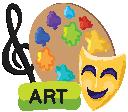

GAMES

INTEGRATED

BHARAT
Bringing creativity and fun into learning by combining music, drama and art with English
Using physical activities, sport and games to make learning active and fun
Cross-curricular and skill linkages to make the learning-experience more holistic, joyful and meaningful
Indianess
Texts and tasks are rooted in the Indian context and culture to develop a sense of national pride

TEAMWORK

SDG
SEL

HANDS-ON
Embracing the spirit of mutual collaboration and cooperation while working together or engaging in a guided conversation
Unwavering commitment to generating awareness of a green, peaceful, prosperous, equitable and inclusive world
Developing the skills to understand and manage emotions, build positive relationships and make responsible choices
Engaging actively in hands-on experiences to acquire knowledge and skills
HOTS
Tasks encourage higher-order skills such as analysing, evaluating, problem-solving and fostering deep understanding

The National Curriculum Framework for School Education (NCF), released in 2022–2023, is developed based on the vision of the National Education Policy (NEP) 2020, and to enable its implementation. The NCF provides guidelines for designing school syllabi and textbooks in India. It aims to improve the quality of education by making it more relevant, engaging, inclusive and learner-centric. To achieve this, the NCF has articulated precise Learning Standards through well-defined Curricular Goals and Competency statements. These statements serve to harmonise the syllabus, content, pedagogical practices, and assessment culture, ensuring a cohesive and comprehensive educational experience.
Curricular Goals: Curricular Goals are statements that give direction to curriculum development and implementation. They are derived from Aims and are specific to a Stage in education.
Competencies: Competencies are learning achievements that are observable and can be assessed systematically. These Competencies are derived from the Curricular Goals and are expected to be attained by the end of a Stage.
NCF Page 56
CG-1
Sustains effective communication skills for day-to-day interactions, enhancing their oral ability to express ideas
CG-2
Develops fluency in reading and the ability to read with comprehension
C-1.1 Listens to poems, stories and conversations and locates important ideas in them
C-1.2 Comprehends narrated/read-out stories and identifies characters, storyline and author’s view
C-1.3 Converses meaningfully and coherently
C-1.4 Makes oral presentations and participates in group discussions
C-2.1 Further develops phonological awareness by blending phonemes/ syllables into words and segmenting words into phonemes/syllables
C-2.2 Examines the basic structure of the text and recognises words and sentences in print and basic punctuation marks
C-2.3 Reads stories and passages fluently and accurately with appropriate pauses
C-2.4 Comprehends the meaning of stories, poems and story posters
C-2.5 Demonstrates an interest in picking up and reading a variety of children’s books
English skills and competencies are thoughtfully mapped to ensure a smooth and progressive learning experience. Beginning with basic concepts at the foundational stage, the curriculum gradually incorporates more advanced skills and concepts at the preparatory stage. This structured approach enables learners to build their competencies each year, equipping them with the necessary language and 21st century soft skills as they progress from grade 1 through grade 5.
C-1.1 Listens to poems, stories and conversations and locates important ideas in them
C-1.2 Comprehends narrated/readout stories and identifies characters, storyline and author’s view
C-1.3 Converses meaningfully and coherently
C-1.4 Makes oral presentations and participates in group discussions
C-2.1 Further develops phonological awareness by blending phonemes/syllables into words and segmenting words into phonemes/syllables
C-2.2 Examines the basic structure of the text and recognises words and sentences in print and basic punctuation marks
CG-1
Sustains effective communication skills for day-today interactions, enhancing their oral ability to express ideas
CG-2 Develops fluency in reading and the ability to read with comprehension
C-2.3 Reads stories and passages fluently and accurately with appropriate pauses
C-2.4 Comprehends the meaning of stories, poems and story posters
C-2.5 Demonstrates an interest in picking up and reading a variety of children’s books
C-3.1 Writes a paragraph to express understanding and experiences
C-3.2 Creates simple posters, invitations and instructions with appropriate information and purpose
CG-3 Develops the ability to express understanding, experiences, feelings, and ideas in writing
C-3.3 Writes stories, poems and conversations based on imagination and experiences
C-4.1 Discusses meanings of words and develops vocabulary by listening to and reading a variety of texts in other content areas
CG-4 Develops a wide range of vocabulary in various contexts and through different sources
SEL

Theme Page: It shows the theme of the unit

Get Set

Do you think sharing is important? Why? Discuss in pairs.
Get Set: A short and fun activity that gets learners excited about the new topic
Draw or paste pictures of any three things that you love sharing with your friends.

Meenu is tired of eating idli-podi for lunch every day, and Kamlesh cannot eat another bite of bhakri-bhaji! What do the classmates do to solve this problem? Let us read the story to find out.
Pre-reading: text to set the context and arouse curiosity


TRRRRRRRIIIIIING.
‘Fine,’ says Nila. ‘But I still have to put on two kilos!’
Let’s Read: Story or poem that is aligned to the theme of the unit
The Queen gives her a bowl of dal and a banana. ‘Eat well,’ she says. ‘You will get there.’
‘Fine,’ says Nila. ‘But I still have to put on two kilos!’
As she eats, Nila remembers the last championship. That was four years ago, when she was just twelve. Prince Vikram of Nethil had won then. He had been far ahead of everyone else.

Talking Book
Talking Book: Animated video of the text
The Queen gives her a bowl of dal and a banana. ‘Eat well,’ she says. ‘You will get there.’
Nila knows Prince Vikram will also be there. She knows she will have to win. After all, she has big plans. Nila wants to go to Taibar, the land of snow. It has the best sports school in the entire kingdom.
‘May I have another banana?’ she asks the Queen. The Queen laughs. Many years ago, she had been like Nila—wanting to run, swim, ride horses and win the championship. But that was a long, long time ago.
As she eats, Nila remembers the last championship. That was four years ago, when she was just twelve. Prince Vikram of Nethil had won then. He had been far ahead of everyone else.
Keywords: Difficult and unknown words from the text with meanings
INTEGRATED
Did You Know?
The school bell rings. It is tiffin time. Meenu finds idli and podi in her tiffin box. When will Amma pack something new? Meenu hates lunch break. Yummy smells waft towards her from other tables. Meenu’s tummy growls and her mouth waters. She pushes her lunch away.

Read and Respond
1. Fill in the blanks.
waft: gently float through the air
Nila knows Prince Vikram will also be there. She knows she will have to win. After all, she has big plans. Nila wants to go to Taibar, the land of snow. It has the best sports school in the entire kingdom.


Did You Know?
Papa
Meenu is tired of eating idli-podi for lunch every day, and Kamlesh cannot eat another bite of bhakri-bhaji! What do the classmates do to solve this
‘May I have another banana?’ she asks the Queen.
Protein is one of the building blocks for your body. It helps to build muscles and bones. Some protein sources are: beans, lentils, nuts and paneer.
The Queen laughs. Many years ago, she had been like Nila—wanting to run, swim, ride horses and win the championship. But that was a long, long time ago.
Did You Know?
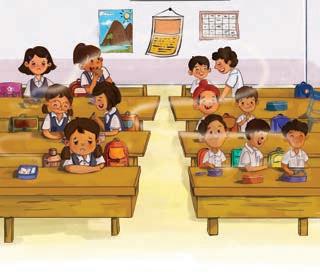
a cooks poha.
Think and Tell


TRRRRRRRIIIIIING.
Think and Tell Why does Meenu hate lunch break? Let’s Read
As the days pass, Princess Nila trains hard. She runs up and down the mountain. She swims in the river. She eats foods that are rich in protein, like curd and dal. Her skin turns golden brown, the colour of sunset. The week before the Championship, she stands on a weighing scale. Fifty-five kilos at last! Nila is thrilled. She flexes her muscles. She cannot stop smiling. ‘I have done it!’
Protein is one of the building blocks for your body. It helps to build muscles and bones. Some protein sources are: beans, lentils, nuts and paneer.

Why does Meenu lunch break?

When you smell tasty food, your mouth starts to make more saliva. This is your body’s getting ready to eat, even if you’re not hungry!
i Papa ii Mumma iii Raghav
b Rishika’s family goes on a picnic near a i park ii zoo iii river
Did You Know?: Interesting facts related to the topic
As the days pass, Princess Nila trains hard. She runs up and down the mountain. She swims in the river. She eats foods that are rich in protein, like curd and dal. Her skin turns golden brown, the colour of sunset.
Why is Nila thrilled?
The school bell rings. It is tiffin time. Meenu finds idli and podi in her tiffin box. When will Amma pack something new? Meenu hates lunch

championship: a big contest to find the best player or the best team weighing scale: a machine to check your weight thrilled: excited flexes: shows muscles by bending arms and legs


c Rishika plays with her at the picnic. i parents ii friends iii brother
The school bell rings. It is tiffin time. Meenu in her tiffin box. When will Amma pack something new? Meenu hates lunch towards her from other tables. Meenu’s tummy growls and her mouth waters. She pushes her lunch away.
Think and Tell: Comprehension-based questions for teachers to assess learners’ attention and understanding while reading
Think and Tell Why does Meenu hate lunch break? 2
d Rishika and her family go home in the i morning ii evening iii afternoon
2. Talk about and answer the questions in class.
a What does Papa do at the start of the story?

waft: gently float through
Did You Know?
Who sits with Rishika at the back of the car?
When you smell tasty food, your mouth starts to make more saliva. This is your body’s way of getting ready to eat, even if you’re not hungry!
Read and Respond
When you smell tasty food, your mouth starts to make more saliva. This is your body’s way of getting ready to eat, even if you’re not hungry!
What do Dada and Dadi do in the car?
Who brings the ball back to Rishika?
cooks poha.
ii Mumma iii Raghav
Rishika’s family goes on a picnic near a
Tips: Quick tips for learners’ support
championship: a big contest to find the best player or the best team weighing scale: a machine to check your weight thrilled: excited flexes: shows muscles by bending arms and legs


c Rishika plays with her i parents
You may look for the answers in the story.
Answer in full sentences.
Put up your hand and take part!
d Rishika and her family go home in the i morning
You can write the answers if your teacher asks you to.

2. Talk about and answer the questions in class.
a What does Papa do at the start of the story?

b Who sits with Rishika at the back of the car?
c What do Dada and Dadi do in the car?


Think and Answer: Questions to help learners to critically analyse the texts
NEP TAGS: To showcase alignment with NEP skills and values
Pronounce Well Listen to the words here.
Think and Answer
Sachi wants to join Meenu and Kamlesh.
5
1. Read the actions of the people in the story. Tick () the reason for the actions.
Read the words aloud. Note that the letters ph and gh make the f sound. phone dolphin laugh photo elephant cough phrase sphere rough graph alphabet tough
Meenu’s mother packs idlis for her every day.
HOTS

Meenu’s mother thinks Meenu likes idlis
Meenu’s grandmother likes idlis
Meenu forces her to do so.
Circle the correct words to complete the sentences. Read the sentences aloud.
Kamlesh shares her tiffin with Meenu.
Kamlesh does not like jowar bhakri and bhaji

Big Idea
a Meenu likes to take pictures with her . i phone ii fone
Think about a time when someone in your family went on a long trip.

Big Skills: Analysis, reflection and connection-based questions
a How did you feel while they were away? How did you feel when they came back?
Meenu’s mother packs extra idlis for Kamlesh the next day.
Meenu told her mother that Kamlesh liked them.
b The zoo has a big i elefant ii elephant
Think about a time when someone in your family went on a long trip.
b How was your experience similar or different to Sundari and Basava’s?

Meenu’s mother wants her to finish all the idlis
c We draw a in the maths class. i graff ii graph
a How did you feel while they were away? How did you feel when they came back?
Pronounce Well Listen to the words here.
Pronounce Well: To develop phonological awareness
Sachi wants to join Meenu and Kamlesh. She likes eating by herself.
2. Complete the sentences with words that mean the same. Use the words in the box.
Work with a partner and take turns to read the words aloud. Then, underline the words that make the sound given in the heading. Some have been done for you.
b How was your experience similar or different to Sundari and Basava’s?


d My favourite animal is a i dolphin ii dolfin
2. Meenu, Kamlesh and all their food. In your notebook, a A new student in school b A friend falls and is hurt Big Idea


Hint Box: draw strong hungry middle little
2. Meenu, Kamlesh and all the other students help each other by sharing their food. In your notebook, write two things that might happen next.
e Meenu took a lovely of the tiffin party. i photo ii foto
a A new student in school forgets to bring lunch.
a There is a (small) bird in that nest.
Pronounce Well
Vocabulary: Exercises to build vocabulary

Big Idea
Listen to the words here.
b A friend falls and is hurt during sports class.
b Rihaal and Nita like to (sketch) during their free time.

Vocabulary
c The table is in the (centre) of the room.
d A (powerful) wind blows across the ocean.
Listen Well: Activity to listen and comprehend 6
What do we learn from the in your life?
Work with a partner and take turns to read the words aloud. Then, underline the words that make the sound given in the heading. Some have been done for you.
What do we learn from the story The Tiffin Gang? How will you apply this in your life?
e The students are (starving) because they did not eat anything.

Go Grammar
Short aLong A sound More long A words Short eLong E sound More long E sounds mat mate stray fell feel be planplanecrayonmetmeeteven sacksake they sweptsweepevening rackrake prey guessgeesefemale am aim ladybet beat thief padpaidbabyspeckspeakniece ran rain breakleftleafpiece manmaingreatlessleastbelieve
Go Grammar: Scaffolding of grammar concepts along with practice exercises
3. Fill in the blanks using a, an and the.
1. Some words have the same or similar meanings. These words are called synonyms. Match the words that mean the same. friend loud noisy dislikes hates buddy gobble clever smart eat
Sentences
We can break a sentence into 2 parts.


Subject (Naming part): The first part is who or what the sentence is about. It can be a person, a place, an animal, or a thing.

a People are watching Surya Championship.
Note: The magic e in words like mate make the short sound in mat long.
Chapter 1 • The Tiffin Gang
b King is sitting on his iron throne.
SEL 7
Remember!
A sentence is a group of words that has a complete thought. Questions are sentences that ask something. 52
Speak Well
c She eats orange everyday.
d Prince Vikram is strong man.
e Princess Nila is good athlete.
Practise speaking here.
Listen Well
Talk to your class about your family in two to three lines.

Predicate (Doing part): The second part is about what the first part does or is. It is about the action in the sentence, so it has a verb (doing word).
Hello!
For example: Meenu hates lunch breaks.
There are 4 people in my family.
Short aLong A sound More long A words Short eLong E sound More long E sounds mat mate stray fell feel be planplanecrayonmetmeeteven sacksake they sweptsweepevening rackrake prey guessgeesefemale am aim ladybet beat thief padpaidbabyspeckspeakniece ran rain breakleftleafpiece manmaingreatlessleastbelieve
Meenu
Speak Well


Listen to the text here.
Listen carefully to the text, and tick () the images that match the tips on how to stay healthy.
My father’s name is Vikas Agarwal. My mother’s name is Saloni Agarwal.
My sister is 7 years old. Thank you! SEL
(The sentence is about Meenu.) hates lunch breaks. (This tells us what Meenu does.)
Practise speaking here.
Note: The magic e in words like mate make the short sound in mat long.
Speak Well: Opportunity to express their ideas and thoughts through independent, pair and group activities
Talk to your class about your family in two to three lines.


Speak clearly and slowly.
Speak in complete sentences.
Listen to your friends when they speak.
My father’s name is Vikas Agarwal.

Write Well
My mother’s name is Saloni Agarwal.
My sister is 7 years old.
Thank you!
Complete the story with the words in the box.

Write Well: Opportunity to apply the learnt vocabulary and express their ideas in writing
Hint Box: football family birds apples biscuits basket
Speak clearly and slowly.
Speak in complete sentences.




Paint with your hands Wash your hands

, bananas, sandwiches and family
Listen to your friends when they speak.
My and I go to the park for a picnic. We pack
Picture description
Introducing others
Listen and fill in key details
Sentences Questions ( wh–words & do questions)
Synonyms
Comprehension Pronunciation
Type
Author/ Poet
S.No Themes Chapter
Informal letter
Discuss the importantc of exercising
Listen and match
nouns
Kinds of
Articles
Word pairs
Singular to plural
Homophones
Write a new ending of a story
Spot the differences
Listen and label the pictures
Adjectives of quantity & quality
Adjectives of comparison
Antonyms Dictionary hunt
Diary entry
Talking about a favourite holiday
Listen and sequence
Personal & possessive pronouns
Travel-related vocabulary
Travel-related vocabulary
Poster making
Group discussion
Listen and fill in key details
Prepositions of time, place and movement
One word for the word group
Ordering Analysisng characters’ actions Making predictions Making inferences & connections ph and gh words with f sound –ph one, lau gh
Magic e words–taptape, pin-pine
Hard and soft th sound wordsth ink , th at
Factual questions
Realistic story
The Tiffin Gang Shweta Ganesh Kumar
1. Friendship
Factual questions
Summarising Identifying problems and solutions Analysisng character Making connections
Factual questions Making inferences
Folktale
The Weighlifting Princess Sowmya Rajendran
2. Health and Hygiene
Poem
M.E. Stokes
The Toothbrush Brigade
3. Health and Hygiene
Factual questions
Ordering Describing characters Making predictions Making connections
Short and long vowel ( a, e ) sounds–mat, mate, fell, feel
Factual questions Identiying setting Identifying problems and solutions Identifying chracters’ feelings Making connections
Factual questions Identifying setting Poetry appreciation– inferring mood
Magical realism
Project 1: Fitness TrackerMy Smart Plan
Doctor, Doctor Sudha Murthy
4. Kindness and Humility
Realistic fiction
Subhadra Sen Gupta
Sailing Home
5. Travel and Tourism
Poem
Santhini Govindan
Travel for Fun
6. Travel and Tourism
Project 2: My Travel Journal
Short and long vowel (i,o,u) sounds–fit, side, hot, pole, sun, tune
Factual questions Analysing character’s feelings Inferring message Making connections
Biography
The Story of Helen Keller
7. Teamwork
Listen and choose the correct answer
Simple present tense Present continuous tense
Collocations
Prefixes and suffixes
Chwords with sounds /ch/ and /k/–chain, chaos
Factual questions Ordering Contextual meaning Making connections
Biographical story
Carpet Sahib
8. Protecting Animals
Interview Invitation 9. Protecting Animals
Picture talk
Listen and mark true or false
Phrasal verbs Verb forms in the simple past tense
Summarising Contextual meaning Making connections Poetry appreciation– creating a poem
Robert Louis Stevenson Poem
The Cow
Prefixes and suffixes 10. Nature
Contractions
Factual questions Identifying problems and solutions Making predictions Making observations silent letters–k, b, w, l, t–thum b , k nife, ca t ch, ta l k, w rite
The Magpie’s Nest Joseph Jacobs Fable
Write a story 11. Nature Wind on the Hill A A Milne Poem
Factual questions Making observations Poetry appreciation– identifying setting Visualisation Homophones
Listen and fill in the key details
Punctuation Simple future tense
Similes Homographs
Factual questions Summarising Identifying key events Identifying problems and solutions Making inferences Making comparisons
Graphic story
Paragraph composition
Debate
Alice in Wonderland
Project 3: Plant a Sapling 12. Imagination and Fantasy
Roleplay Dialogue writing 13. Humour The Pot Face
Listen and fill in a chart
Adverbs
Compound words Anagrams
Syllables– break words into syllables
Folktale Factual questions Identifying characters’ actions Identifying problems and solutions Retelling the main events Analysing characters Making connections
Rhyming words
Retelling the main events Factual questions Making connections Poetry appreciation– imagery
14. Humour I Woke Up This Morning Kenn Nesbitt Poem
Share a Story Writing instructions
Listen and answer the riddles
Conjunctions
Idioms
Different spellings of the long I sound–pie, pine, shy, high
Folktale Factual questions Ordering Analysing characters and their actions Identifying cause and effect Making connections
Project 4: Spreading Laughter 15. World Story Momotaro, the Peach Boy

—Shweta Ganesh Kumar





Get Set

Draw or paste pictures of any three things that you love sharing with your friends.
Do you think sharing is important? Why? Discuss in pairs.
Meenu is tired of eating idli-podi for lunch every day, and Kamlesh cannot eat another bite of bhakri-bhaji! What do the classmates do to solve this problem? Let us read the story to find out.


Let’s Read
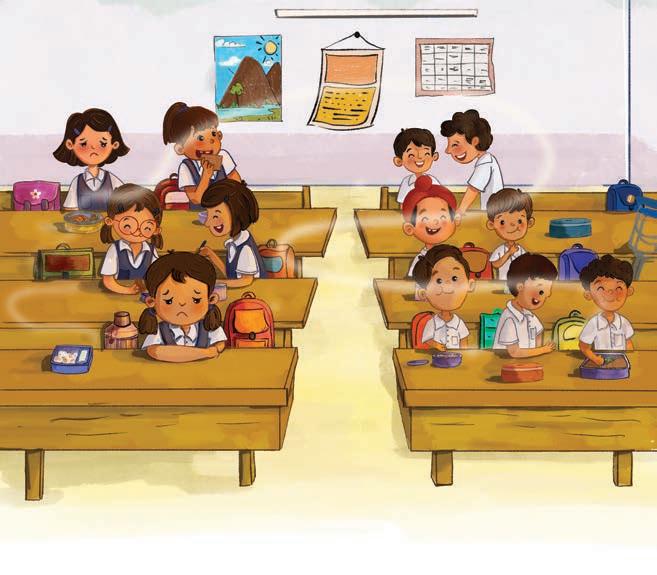
TRRRRRRRIIIIIING.
The school bell rings. It is tiffin time. Meenu finds idli and podi in her tiffin box. When will Amma pack something new? Meenu hates lunch break. Yummy smells waft towards her from other tables. Meenu’s tummy growls and her mouth waters. She pushes her lunch away.
waft: gently float through the air
Why does Meenu hate lunch break?

When you smell tasty food, your mouth starts to make more saliva. This is your body’s way of getting ready to eat, even if you’re not hungry!


Three rows behind,
Kamlesh is sulking. Meenu thinks Kamlesh’s tiffin looks yummy. Does she not like it?
Kamlesh looks up and sees Meenu with her tiffin box. ‘Amma has sent me idlis again,’ says Meenu. Kamlesh shrugs at her own box. ‘Jowar bhakri and bhaji. Again.’
Meenu’s tummy rumbles. GUR! GUR!!!
‘Can I taste it?’ asks Meenu.
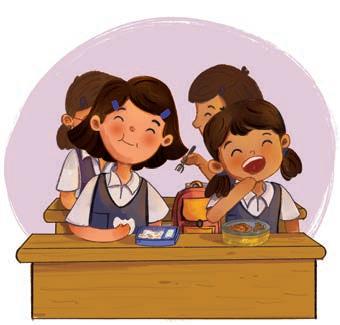
Kamlesh brings her tiffin to Meenu and grabs Meenu’s box. Kamlesh gobbles up Meenu’s idlis. Meenu wolfs down Kamlesh’s jowar bhakri.
How do you think Kamlesh felt when she saw Meenu’s tiffin?
The next day, Meenu counts the minutes to tiffin time. Amma has packed extra idlis for Kamlesh. Trrrrrring! The bell rings. Lunch break!
Kamlesh slides over to make space for Meenu. Today, Kamlesh’s box is filled with mutke. Sachi comes over with her tiffin box. ‘I have pakhala bhata with potatoes. I saw both of you sharing your tiffin yesterday,’ she says. ‘Can I join in?’
‘Yes, yes, Sachi!’ says Meenu.
She stands up and bangs her tiffin box lid on the desk.
sulking: being sad and angry shrugs: lifts shoulders to show that the person is not interested gobbles up: eats food very quickly because it tastes very good wolfs down: eats food very quickly when hungry
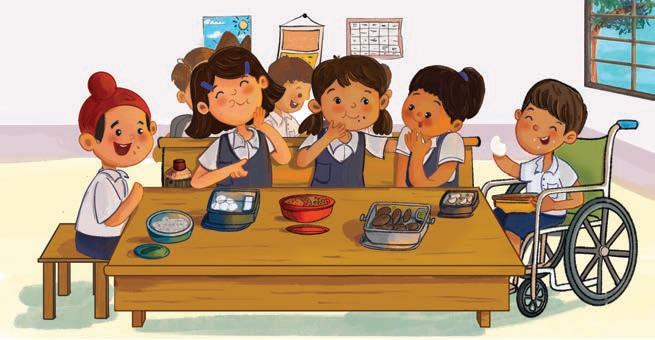
‘Attention, everyone! Kamlesh, Sachi and I are having a tiffin party. Today we will eat idlis, mutke and pakhala bhata. Who wants to join us?’
What are all the different types of food you read about in this story?
There is a scramble. The whole class crowds around Kamlesh’s desk for the tiffin party. Some tiffin boxes have a little food in them, some have lots. Some have spicy food, some sweet. Some have tangy pickles and some bitter karela. But there is enough to fill all the hungry tummies in the room.
Meenu loves tiffin time now. Why would she not when every day is a party?
New dishes we read about:
Idli podi: Idli served with ghee and spicy powder
Pakhala bhata: Rice soaked in water and served cold
Jowar bhakri and bhaji: Indian bread made with jowar served with cooked vegetables
scramble: a rush to get somewhere quickly crowds around: comes together at one place tangy: a sharp, sour taste like that of a lemon
Mutke: This is a Maharashtrian dish. It is made with lentils and bottle gourd.
Listen to all the keywords here.





1. Circle the correct answers.
a What does Meenu bring for lunch?
i Idli and podi ii Jowar bhakri and bhaji
iii Mutke iv Pakhala bhata
b Who brings mutke for lunch?
i Meenu ii Kamlesh iii Sachi iv Shamit
c What do Meenu and Kamlesh decide to do?
i Eat their own lunches ii Exchange their lunches
iii Throw away their lunches iv Buy some new food
d What does Meenu’s mother do for Kamlesh?
i Packs a few extra idlis ii Packs a few extra rotis
iii Packs her dinner iv Sends pakhala bhata
e Who brings pakhala bhata with potatoes?
i Shamit ii Kamlesh iii Meenu iv Sachi
2. Number the events 1–5 the way they happen in the story.
a Kamlesh shares her jowar bhakri and bhaji with Meenu.
b Meenu finds idli and podi in her tiffin box.
c All the children in the classroom enjoy sharing their tiffins.
d Meenu’s mother packs three extra idlis in a tiffin box.
e Sachi brings pakhala bhata with potatoes in her tiffin.
3. Answer the questions in one to two sentences.
a Which words tell us that Meenu is hungry?
b How does Kamlesh feel when she opens her tiffin?
c What problem do Meenu and Kamlesh have?
d How does the class react to the tiffin party?
e Why does Meenu love tiffin time by the end of the story?



1. Read the actions of the people in the story. Tick () the reason for the actions.
Meenu’s mother packs idlis for her every day.
Kamlesh shares her tiffin with Meenu.
Meenu’s mother packs extra idlis for Kamlesh the next day.
Sachi wants to join Meenu and Kamlesh.
Meenu’s mother thinks Meenu likes idlis.
Meenu’s grandmother likes idlis.
Meenu forces her to do so.
Kamlesh does not like jowar bhakri and bhaji.
Meenu told her mother that Kamlesh liked them.
Meenu’s mother wants her to finish all the idlis.
She likes eating by herself.
She thinks sharing food is a good idea.
2. Meenu, Kamlesh and all the other students help each other by sharing their food. In your notebook, write two things that might happen next.
a A new student in school forgets to bring lunch.
b A friend falls and is hurt during sports class.


Big Idea

What do we learn from the story The Tiffin Gang? How will you apply this in your life?




Pronounce Well Listen to the words here.
Read the words aloud. Note that the letters ph and gh make the f sound. phone dolphin laugh photo elephant cough phrase sphere rough graph alphabet tough
Circle the correct words to complete the sentences. Read the sentences aloud.
a Meenu likes to take pictures with her . i phone ii fone
b The zoo has a big . i elefant ii elephant
c We draw a in the maths class. i graff ii graph
d My favourite animal is a . i dolphin ii dolfin
e Meenu took a lovely of the tiffin party. i photo ii foto

Vocabulary

1. Some words have the same or similar meanings. These words are called synonyms. Match the words that mean the same. friend
noisy

2. Complete the sentences with words that mean the same. Use the words in the box.
Hint Box: draw strong hungry middle little
a There is a (small) bird in that nest.
b Rihaal and Nita like to (sketch) during their free time.
c The table is in the (centre) of the room.
d A (powerful) wind blows across the ocean.
e The students are (starving) because they did not eat anything.

Go Grammar

We can break a sentence into 2 parts.
Subject (Naming part): The first part is who or what the sentence is about. It can be a person, a place, an animal, or a thing.
Remember!
A sentence is a group of words that has a complete thought. Questions are sentences that ask something.
Predicate (Doing part): The second part is about what the first part does or is. It is about the action in the sentence, so it has a verb (doing word).
For example: Meenu hates lunch breaks. Meenu (The sentence is about Meenu.)
Subject hates lunch breaks. (This tells us what Meenu does.)
Predicate


1. Circle the subjects and underline the predicates in the sentences. Double underline the verbs.
a Kamlesh shrugs at her own box.
b Meenu wolfs down Kamlesh’s jowar bhakri.
c The whole class crowds around Kamlesh’s desk.
d Sachi comes over with her tiffin box.
e Meenu loves tiffin time now.
2. Match the subjects and the correct predicates. Amma waft towards Meenu. Meenu’s mouth looks yummy.
Kamlesh’s tiffin gobbles up Meenu’s idlis.
Yummy smells packs idli and podi in the tiffin box. Kamlesh waters.
Questions
A question asks us something. We can make questions in two ways.
Wh-words: We use wh-words to start questions. These words are what, why, when, who, where, and how.
Wh-words Use Example
When asks about time
Where asks about a place
What asks about things, animals and actions
When will the bell ring for lunch?
Where is Kamlesh sitting?
What is in your tiffin?
Why asks about the reason Why is Meenu tired of idlis?
Who asks about a person
Which asks about a choice
How asks about the way something happens
Who is eating idli?
Which is my tiffin?
How does Meenu look at her tiffin?
Do-words: These words are do, does and did. Questions with do-words can have yes or no as answers.
Does Does is used to ask about he, she or it. It is used in sentences about everyday events. Does Meenu eat Idli podi every day?
Do Do is used with I, you, we and they. It is used in sentences about everyday events.
Do the girls have a tiffin party every day?
Did Did is used in sentences about the past. Did you eat your food yesterday?
Look at how we use the simple form of the verb (doing word) after Does and Did.
Meenu eats idli every day. Does Meenu eat idli every day?
Meenu ate an idli yesterday. Did Meenu eat an idli yesterday?
3. Use the correct WH words to form the questions.
a Sachi has pakhala bhata in her tiffin. has pakhala bhata in her tiffin?
b There is mutke in Kamlesh’s tiffin. is in Kamlesh’s tiffin?
c The tiffin party is around Kamlesh’s desk. is the tiffin party?
d The red tiffin has sandwiches and noodles. tiffin has sandwiches and noodles?
e The girls meet at lunch time. do the girls meet?
4. Use the correct DO words to form questions.
a Meenu and Kamlesh shared their tiffin. Meenu and Kamlesh their lunch?

b The tiffin boxes have lots of food.
the tiffin boxes have lots of food?
c Sachi joins Meenu and Kamlesh.
Sachi join Meenu and Kamlesh?
d Amma packed extra idlis for Kamlesh.
Amma pack extra idlis for Kamlesh?


Listen to the text here.
Listen carefully to the text and fill in the blanks with the correct words. Sonu is new in town and feels nervous about making new . One day, he decides to go to the to play. In the park, Sonu meets . They play together, laugh and have fun. They ride on the and go down the slide. Sonu feels because he has made a new friend.



Practise speaking here.
Sit in pairs. Ask each other questions and then introduce your partner to the class. For example:
What is your name? My name is Meena.
What is your favourite activity? I like to draw and paint. Tell me one interesting thing about yourself. I have a pet dog named Tiger.

Use the answers to introduce your friend to the class.
For example:
Hi, everyone! I want to introduce you to my friend. This is Meena. Meena likes to draw and paint. An interesting thing about Meena is that she has a pet dog named Tiger.



Look at the picture carefully. Write four sentences to describe the picture.






























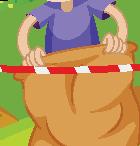





















Get Set

Which events would you like to take part in on Sports Day? Tick () them.
Princess Nila is preparing herself for the Surya Championship. She is training very hard. Why is it so important for her to win? Let us read the story to find out.


Princess Nila is worried.
The Surya Championship, the famous weightlifting contest in her kingdom, is only a month away. But according to the rules, she must weigh 55 kilos. She still has to put on two kilos!
The Surya Championship was named after the greatest athlete in all the seven kingdoms of the east. Nila has waited all her life to participate.
Nila loves to lift weights. As a child, she would lift dogs, chairs, tables, and cupboards… and even the King!
‘How did practice go?’ asks the Queen.
Out of the things Nila lifted, which one do you think was the most difficult to lift? Why?
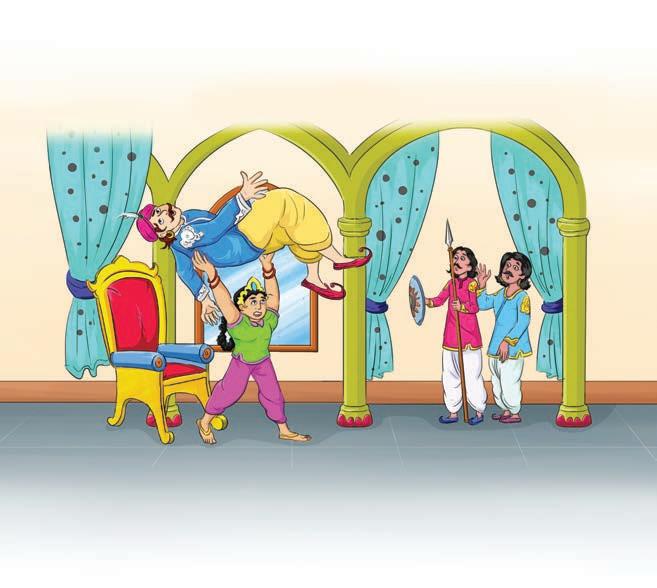
weightlifting: a sport where people pick up heavy things to show they are strong contest: a competition where people take part and try to win athlete: someone who plays a sport, often running participate: take part in

‘Fine,’ says Nila. ‘But I still have to put on two kilos!’
The Queen gives her a bowl of dal and a banana. ‘Eat well,’ she says. ‘You will get there.’
As she eats, Nila remembers the last championship. That was four years ago, when she was just twelve. Prince Vikram of Nethil had won then. He had been far ahead of everyone else.
Nila knows Prince Vikram will also be there. She knows she will have to win. After all, she has big plans. Nila wants to go to Taibar, the land of snow. It has the best sports school in the entire kingdom.
‘May I have another banana?’ she asks the Queen.
The Queen laughs. Many years ago, she had been like Nila—wanting to run, swim, ride horses and win the championship. But that was a long, long time ago.

Protein is one of the building blocks for your body. It helps to build muscles and bones. Some protein sources are: beans, lentils, nuts and paneer.
As the days pass, Princess Nila trains hard. She runs up and down the mountain. She swims in the river. She eats foods that are rich in protein, like curd and dal. Her skin turns golden brown, the colour of sunset.
The week before the Championship, she stands on a weighing scale. Fifty-five kilos at last! Nila is thrilled. She flexes her muscles. She cannot stop smiling. ‘I have done it!’
Why is Nila thrilled?

championship: a big contest to find the best player or the best team weighing scale: a machine to check your weight thrilled: excited flexes: shows muscles by bending arms and legs

On the day of the Championship, Nila is ready. This year, the competition is tougher. Nila marks out the strong weightlifters—the boy with the yellow turban, the girl with the tight braid, and of course, Prince Vikram. They lift rocks, logs, treasure chests and cupboards. The judges watch. Is the arm shaking? Is the leg steady? Is the stance correct? Nila clenches her teeth. She can feel every muscle in her body and every drop of sweat. Vikram is in the lead, but Nila is right behind him. The final round begins. They have to lift the ancient iron throne. The others are good, but Nila is better. She applies every ounce of her strength. She grunts, biting back the pain. When she almost gives up, she thinks of Surya, and Taibar. The iron throne rises in the air.
The final scores are displayed. Princess Nila has won! Princess Nila smiles and says, ‘I am the champion.’

Karnam Malleswari was the first Indian woman to win a medal in weightlifting. She won a bronze medal at the Olympics in 2000.
marks out: notices carefully stance: the way someone stands clenches: presses together tightly ancient: something which is very, very old ounce: a small unit used to measure weight grunts: makes a noise through the teeth when trying very hard to do something displayed: showed
Apart from working very hard, what else made Nila the champion?
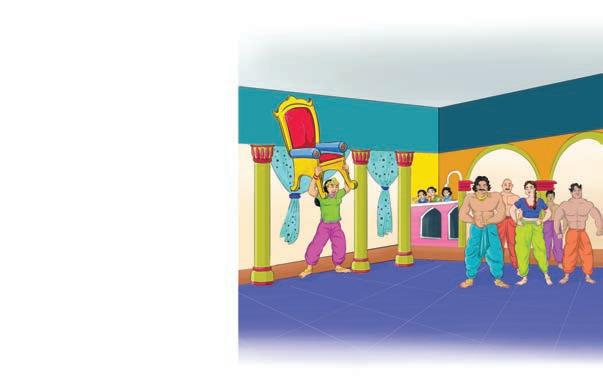
Listen to all the keywords here.




Read

1. Complete the summary of the story with the words in the box.
Hint Box: throne heavy weights Taibar fifty-five Surya Championship
Princess Nila loves to lift . She wants to take part in the . For the weightlifting competition, Nila has to weigh kilos. She wants to win the competition and go to . On the day of the competition, Nila lifts an ancient iron . Princess Nila wins the competition.
2. Answer the questions in two to three sentences.
a What is the Surya Championship? Why does Princess Nila want to take part?
b Why does the queen understand her daughter ’s wish to win?
c What does Princess Nila do to prepare for the championship?
d Who are the other athletes competing against Princess Nila?
e What do the judges watch for when the participants lift weights?


Think and Answer

1. In your notebook, write how Princess Nila solves these problems.
a She has to increase her weight.
b She finds the iron throne very heavy.
2. Use the sentence starters to write about Princess Nila.
The main person in the story is...
In the beginning she worries about...
I say so because...
She likes...
I say so because...
Her dream is to...
I know it because... She is a... girl.


Big Idea
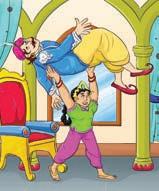
Imagine that your school is organising a competition. You wish to take part and do well. Complete the table to write your plan.
To participate in the competition, I will follow a timetable.
I will study from to .
(time) (time) (time)
I will start practising at . I will ask for help. (who can help you)
I will need more energy. I will eat healthy food.
(Name the things you will add to your diet.)
I will and to relax. (activities you will do to relax)




Pronounce Well Listen to the words here.
The magic e makes a short sound long. Rip–ripe, tap–tape, cut–cute, cop–cope.
Read these words aloud. ripe tape cute cope pipe cape tube rope wipe made robe hope site fate note spine
Look at the pictures. Circle the magic e words in the word grid. Then, write them and say the words aloud.

k l t a p e i f s h a m t p i n e c e u i f d o
t d w o i n s h r o p e


Vocabulary















1. Match the words that go together. Fill in the blanks with the pairs. tea butter bread pepper salt fork knife paper pen biscuits
a Princess Nila makes her diet chart using and .
b Princess Nila does not include and in her diet plan.
c Princess Nila likes to eat and for breakfast.
d Princess Nila eats her food with a and .
e Princess Nila adds and to her salad.
Singular (One) to Plural (Many)
We add -s or -es at the end, to make most words plural.
For example: cat – cats, block – blocks, park – parks
We add -es to words that end in -s, -x, -z, -ch, or -sh.
For example: box – boxes, bus – buses, crash – crashes
Remember!
Plurals (Many) — When we talk about more than one person, animal or thing, we use plurals.
2. Fill in the blanks by choosing the correct plural forms.
a The (princesss/princesses) wore sparkling dresses to the ball.
b The weight-lifting (matchs/matches) were tough.
c Princess Nila ate (sandwichs/sandwiches) after the competition.
d The (judgs/judges) announced the final decision.




Common nouns are the names of any person, animal, thing or place. Proper nouns name a specific person, animal, thing or place. A proper noun always begins with a capital letter.
She is a girl.
Remember!
Nouns (Naming Words) are words for people, things, actions and places.
She is Nila. She lives in a town. She lives in Taibar.
Collective nouns are words used to describe groups of people, animals, or things as a single unit.
For example:
I bought a bunch of roses for my mother. I saw a flock of birds flying.
an army of soldiers a colony of ants a galaxy of stars a choir of singers a herd of sheep a stack of books a team of players a school of fish a deck of cards
1. Underline the common nouns and circle the proper nouns in the sentences.
a The Surya Championship is a famous contest.
b The Queen of Taibar eats a banana every day.
c Princess Nila lifted tables and even the throne.
d There is a sports school in Taibar.
e Nila swims in the Brahmaputra river.

The Brahmaputra River is one of the longest rivers in India. It starts high up in the mountains in Tibet, travels through India, and finally flows into Bangladesh.
2. Fill in the blanks with one of the collective nouns in the box.
Hint Box: swarm herd bunch class flock
a a of grapes
c a of birds
b a of students
d a of bees
e a of elephants



Articles (a, an, and the)
We use a and an when talking about any one thing, person or group for the first time or if the noun is not specific. For example: I met a kind woman today. She is an athlete. (one of many)
I saw a herd of cows. (not a specific herd)
We use a before consonant sounds and an before vowel sounds.
We use the when talking about a specific thing or person. It is used for something that is one-of-a-kind or something that is known. For example: She is the Queen of England, Princess Nila lifted the golden throne. Here, we are talking about a specific queen or throne.

3. Fill in the blanks using a, an and the.
a People are watching Surya Championship.
b King is sitting on his iron throne.
c She eats orange everyday.
d Prince Vikram is strong man.
e Princess Nila is good athlete. Listen to the text here.



Listen carefully to the text, and tick () the images that match the tips on how to stay healthy.

Drink water
Brush your teeth



Practise speaking here. Speak Well
If we want to stay healthy and fit, we need to exercise. Talk about ‘The Importance of Exercising’ with your partner.
How can we stay healthy? We should exercise regularly.
What do you do for exercise? I do yoga every day.


Make eye contact with your partner.
Take turns to ask more questions about the topic.
Listen carefully to your partner’s ideas.
Speak clearly.




We write informal letters to people who are close to us, like our friends and family. An informal letter has the following sections:
Model Answer
123, Block B
Raj Garden Road Hyderabad 500001
15 July 2025
Dear Grandma, How are you? I hope you are well and that you are eating healthy food and getting enough rest after getting out of hospital. I am doing well. I am studying hard at school. I am also practising every day to get ready for the school athletics competition.
Take care, and see you soon.
Love, Avinash
Your home address with pincode Date of writing the letter
Greeting
Body, the main part of the letter
Closing and your signature

Write a letter to a friend who has been sick and absent from school for some time now. In your letter, ask about their health and give some advice.



Write five things you do every day to keep yourself clean. 1.
5. Discuss why it is important to stay clean.
A group of friends come together to form a club. They decide to brush their teeth every day, but why is it so important? Let us find out from the ‘Toothbrush Brigade.’


Let’s Read

The toothbrush brigade is a happy club
We boys and girls have made, We try to care for our teeth So they’ll not be decayed. And so we have promised one and all, At morning and at night, To brush them clean and white.
brigade: a group of people who do something together decayed: rotten and full of holes

Chapter 3 • The Toothbrush Brigade
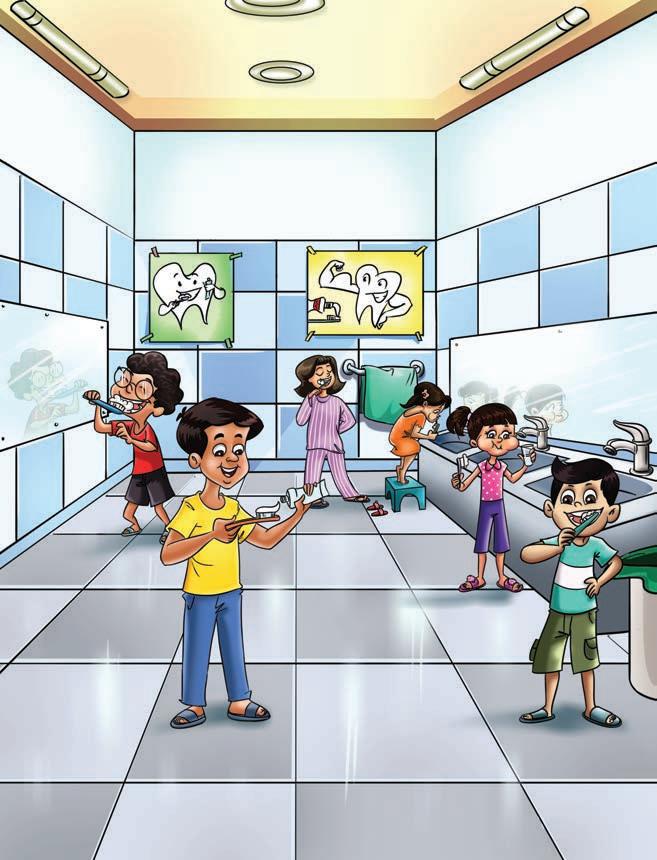
First across we’ll brush them, Well then up and down we go, Then open wide the mouth, you see, And do just as before. So carefully we’ll rinse them, too, You’ll see a healthy sight. Our teeth so clean and white.
And now my friends a word to you
Before we leave the stage, If your teeth you would preserve, Down to a nice old age, Get your toothbrush and water, too, And start this very night To brush them clean and white.

Did You Know?
Eating too much candy and drinking too many soft drinks can give you holes in your teeth. This is called tooth decay, and it can be very painful!
rinse: to wash and clean with water preserve: to keep safe and healthy for a long time
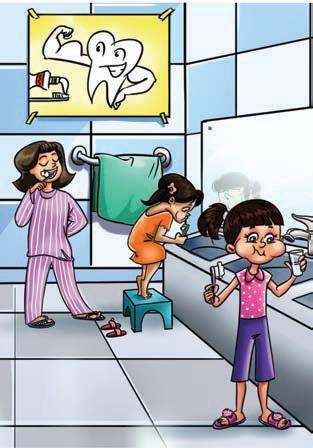
Think and Tell
What are the steps in the poem that tell you how to brush your teeth properly?
Listen to all the keywords here.





1. Choose the correct answers.
a What do the boys and girls form?
i A club to take care of their hair
ii A club to take care of their teeth
b What do the boys and girls promise to do in the morning and at night?
i Brush their teeth
c How do they brush their teeth?
i Up and down
ii Eat candy
ii Across/up and down
d What do they do after brushing their teeth?
i Go to sleep
ii Rinse their teeth
e What do they want their teeth to look like?
i Clean
ii Yellow
2. Answer the questions in two to three sentences.
a Why do the boys and girls form the Toothbrush Brigade?
b What happens if we do not take care of our teeth?
c What are the correct steps to brush our teeth?
d What is the message at the end of the poem?




Idea
In a poster, we give a heading, a drawing and a slogan. A slogan is a short and catchy message that helps people remember something important. For example:
Smiling Teeth

Brush right,
Smile bright!
Heading
Drawing
Slogan
Make a fun poster to tell your friends and family about the importance of brushing their teeth. You can choose a heading and a slogan from those given or make your own.
Smiling Teeth
Healthy Teeth
Keep a Bright Smile
Brush for a Healthy Mouth
Keep Teeth Sparkling


Vocabulary
For example:
Brush twice a day, keep the rot away! Brush twice a day, keep the dentist away! Be a good boss, brush and floss! Don’t rush, brush, brush brush! Healthy habits start with brushing!
We had a great time at the school fair. (Here fair means an event with games and rides.) Our mother is fair and listens when we speak. (Here fair means someone who does not take sides.)
Remember!
Homophones are words that have the same spelling and sound, but can have different meanings in different sentences.


Fill in the blanks with words in the box. Each word can be used twice.
Hint Box: can well match light park
a Please pass me the of paint.
b She sing beautifully.
c I hope you get soon.
d The room is filled with .
e We watched a cricket yesterday.
f Let’s go to the and have a picnic.
g The suitcase is very .
h In my grandfather’s village, people get water from the .
i Don’t the car in front of the store.
j Father needs a to light the campfire.



The title of a poem helps the reader understand what the poem is about. It is used to get the reader interested.
a Think about the title ‘Toothbrush Brigade’. What came to your mind when you first read the title?
b Did your idea change after reading the poem?
c If you could change the title, what would you choose as the title?


Fitness Tracker — My Smart Plan
You will track your physical activities and the healthy food you eat, for two weeks! This project will help you see how staying active and eating well can make you strong and healthy.


Materials Required:

• Your English notebook
• A pencil or a pen Steps:
• The Fitness T racker
1. Think about the physical activities you do e very day, like playing outside, riding your bike, dancing, running, or even walking your dog.


2. Also, think about the healthy food you eat, like fruit, vegetables, whole gr ains, and dairy products.
3. Pr actise a healthy lifestyle for two weeks. Each day, do at least one activity and eat healthy and nutritious food.
4. Every day , write down the date, what activity you did, for how long you did it, what healthy food you ate, and how you felt afterwards (happy, tired, strong, energised, etc.).
5. After two weeks, write a fe w sentences in your notebook about what you learnt from tracking your fitness and eating habits. Did you feel better when you were active and ate healthy food? Would you like to try any new activities or food?
Share your fitness and food tracker with your class and talk about what activities and food you enjoyed the most.








Get Set

Talk to your friend about a time when you saw someone in need of help and how you helped them. Look at the pictures for ideas or talk about your own experience.
Injured animal
Struggling old man
Crying friend
Discuss what happened, what you did and how they felt.
Ravi is not a doctor, but he has a gift for healing people. Soon Ravi loses his blessing. Let us read to find out what happens.



Let’s Read
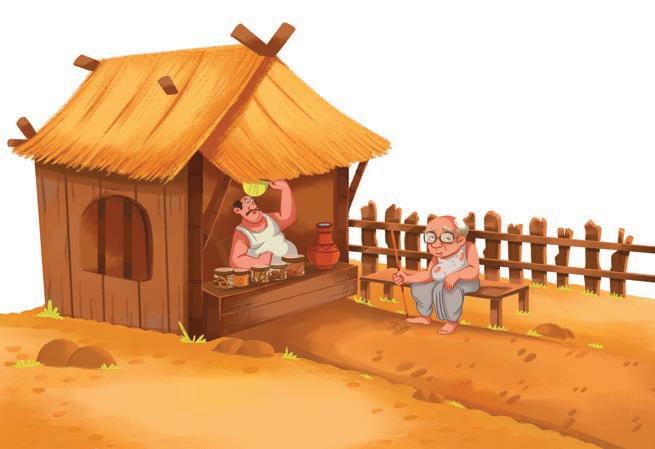
Talking Book
On a hot summer afternoon, an old man hobbled down a village road. He was very thirsty. He saw a tiny grocery store in the distance. When he reached the store, he sat down on a bench outside and uttered only one word, ‘Water!’ The village hadn’t had any rain for two years leaving everyone with very little stored water. But Ravi, the shopkeeper, was kind. He gave the old man a cup of water from his pot. The old man finished it in one gulp. He asked for more and then, without waiting for Ravi, took the pot and drank all the water in it. Ravi was shocked; but he thought, ‘Never mind. After all, I did help someone in need.’

How do you know that the old man was really thirsty?

A long dry period for months or years without rain is called a drought. It is not good for our health, environment or agriculture.
hobbled: walked in small steps with limp gulp: (here) big swallow

The old man, now feeling better, smiled and said, ‘My son, always be kind like this. Help everyone like you helped me, and you will be blessed.’ He then slowly walked away.
Soon after, young Karim limped into Ravi’s shop. He was also thirsty, and his leg hurt him. While Ravi was packing Karim’s groceries, Karim ate his lunch sitting on the bench. When he asked Ravi for some water. Ravi said, ‘I’m sorry, Karim. I have no water left.’
‘But your pot is full!’ said Karim.
Ravi looked at the pot in disbelief—it was filled with water. Karim took some water and drank it, sighing with relief. As Karim left, it seemed as if his limp had almost gone. Ravi’s eyes widened in surprise.
Did the water really heal Karim’s leg? He wondered if the old man’s words were coming true. Was he really blessed?
Do you think Ravi is daydreaming or has he been blessed?
Soon, news spread in the village about Ravi’s pot of magic water. The villagers gathered outside Ravi’s shop every day. He gave each of them some water from his pot and never charged a single paisa. After all, what was better than the blessings of the people?
A year passed. Once again, on a hot summer day, an old, thirsty man visited Ravi’s shop, begging for a drop of water. At the same time, a messenger came from the king—the queen had been bitten by a mosquito and needed the magic water.
Ravi was tempted by the handsome reward he would get. He took his pot of water to the royal palace without helping the old man.
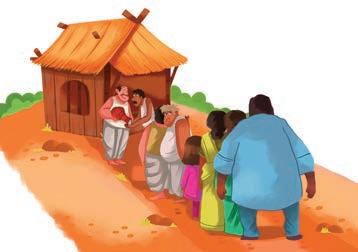
limped: walked with difficulty widened: grew big wondered: thought gathered: came together tempted: attracted reward: prize given for help or work

Why did Ravi choose to help the Queen?
When the queen asked for the magic water, Ravi tried to pour it into the tumbler. The pot was as dry as a bone! The king was furious. He threatened to banish Ravi from the village. Scared and ashamed, Ravi left the palace and returned to his shop. He searched for the old man everywhere but could not find him. He realised his mistake— his greed had cost him the magic water. He sadly remembered how much joy and love he had received from helping people out of kindness, and not for money.
From that day on, he again walked to the faraway stream and filled his pot with ordinary water. He waited for the old man to return. Until then, he decided he would help people by bringing a doctor to the village.


dry as a bone: very dry furious: very angry banish: send away
Listen to all the keywords here.



1. Choose the correct answers.
a How long had the village been without rain?
i six months
iii two years
ii one year
iv ten years
b What happened when Karim drank water from Ravi’s pot?
i Karim’s limp became better. ii He got sicker.
iii There was no change.
iv He fell asleep.
c How much did Ravi charge for his magic water?
i one Rupee
iii five Rupees
ii three Rupees
iv nothing
d Who needed the magic water from the palace?
i the King
iii the Prince
ii the Queen
iv the Princess
e What did Ravi decide to do after losing his magic water?
i He left the village.
iii He stopped helping people.
ii He bought a new pot.
iv He brought a doctor to the village.
2. Number the events 1–5 in the correct order.
The old man blesses Ravi.
The queen is bitten by a mosquito.
Karim’s limp improves after drinking the water.
Ravi’s pot becomes dry at the palace.
News spreads about Ravi’s magic water.
3. Answer the questions in two to three sentences.
a What problem did the people in Ravi’s village face?
b What did Ravi realise after Karim’s limp seemed better?

c Why did Ravi choose to help the Queen instead of the old man?
d Why did the king threaten to banish Ravi from the village?
e What did Ravi miss after he had lost his magic?



1. Think about how Ravi changed from the beginning to the end of the story. Use adjectives to describe Ravi at the beginning, middle and end of the story.
2. Read about the characters’ actions. Write what the characters’ thoughts could have been.
The old man took the pot and drank all the water in it.
Ravi thought that .
Karim drank water from the pot, and his limp went away. Karim thought that .
The king called Ravi to the palace with his healing water.



The king thought that .
Think of the problems faced by the people in your neighbourhood. Imagine that you could develop magical powers to help. What power would you ask for? What problem would you solve?
People in my area face this problem:

I wish I had this power to help everyone:
I chose this power because:


Pronounce Well
Listen to the words here.
How to produce the hard and soft ‘th’ sound.
Hard ‘th’ sound Soft ‘th’ sound
• Place your tongue between your upper and lower teeth.
• Put your fingers on your vocal cords and say ‘this’.
• You should feel a buzzing sensation.
For example: this, that, these, those, brother, mother
• Place your tongue between your upper and lower teeth.
• Put your fingers on your vocal cords but this time say ‘think’.
• You will not feel the same buzz as the vocal cords do not vibrate.
For example: think, thin, thank, bath, both, month
Say the words aloud. Fill in the blanks with the ‘th’ words in the box.
Hint Box: mother those thank brother this think
a Rohan gave me apple.
b My helps me with Maths.
c Please your uncle for the gift.
d I need to before I make a decision.
e She prefers books to these ones.
f My drives me to school.




Opposites or antonyms are pairs of words that have opposing meanings. For example: old is the opposite of young tiny is the opposite of huge
1. Fill in the blanks with the correct pairs of opposite words in the box.
Hint Box: kind/cruel hot/cold full/empty blessed/cursed rewarded/punished
a On a day, everyone wishes for weather.
b The pot was in the morning but by the evening.
c Ravi was to the villagers but the king was to them.
d Ravi felt when he had the healing water but when he lost it.
e Ravi was for his kindness, but the evil minister was for his unkind acts.
A dictionary is a special book that tells you the meaning of words. It also helps you learn how to spell and say words correctly.
• Words in a dictionary are listed in alphabetical order, A, B, C, and so on.
• To find a word, look for that letter in the dictionary. For example, if you are looking for apple, go to the A words.
• At the top of each dictionary page, there are two words called guide words. These words show the first and last words on that page.
• If your word comes between these two guide words alphabetically, it means your word is on that page.
2. Use a dictionary to arrange the following words in alphabetical order. Write them in your notebook.
empty dry magic everything never being near blessed drink mean


Adjectives of quality tell us what something is like or how it looks or feels. They tell us about the quality of a noun (naming word).
For example: The brave king called Ravi. The brown dog ran fast.
Adjectives (describing words) tell us something more about a person, place, animal or thing.
Ask ‘What kind?’ ‘How does it look?’
Adjectives of quantity tell us how many or how much there is of a noun.
For example: Ravi has one pot. Ajji knows many stories.
Ask ‘How much?’ ‘How many?’
1. Circle the adjectives of quality. Underline the adjectives of quantity.
Hint Box: Remember to ask: How? / What kind? or How much? / How many?
a Ravi was a helpful man.
b The tall man wanted more water.
c Many people came outside Ravi’s small shop.
d Karim’s injured leg had worried him for many years.
e Poor people would leave a few rupees or some food.








The blue pot is small. The blue pot is smaller than the brown pot. The blue pot is the smallest of all the pots.
Positive degree Comparative degree Superlative degree
We do not compare the noun with anything. We compare two things. We compare three or more things. Add -er or more to the adjectives. Add -est or most to the adjectives.
We add -er or -est to short adjectives. For example:
Positive degree
Comparative degree Superlative degree brave braver bravest
We add more or most to longer adjectives with two or more syllables. For example:
Positive degree
Comparative degree Superlative degree difficult more difficult most difficult
2. Fill in the blanks with the comparative or the superlative form of the adjectives.
a Ravi is (helpful) than Kishan.
b Today is the (hot) day of the month.
c The man was (old) than Ravi.
d Raghu was (interested) in Maths than Meenu.
e Ravi’s shop is the (tiny) shop in the village.
f Water is (precious) than gold.
g The king will give the (handsome) reward you can imagine.


Listen Well

Listen to the text here.
Listen carefully to the text and number the pictures from 1–6 in the correct order.





Practise speaking here.
Sit in pairs. Look at the pictures and find the differences between them. After you have found at least four differences, tell your friend about them. Hint Box: There are six differences.

You can use sentences like:
• In the first picture, I see . But in the second picture, I see .
• In first picture but in the second picture .



Take your time to look at the pictures carefully.
Use simple, short sentences when you speak.

Sit in a group of four. Read the story together and summarise the key events of the story. In your notebook, discuss and write a new ending.
In a village near a big forest, there was a poor woodcutter named Hari. One day, his axe fell into a river while he was working. Hari was very sad and started crying.
Suddenly, a river goddess appeared and asked, ‘Why are you crying?’
Hari told her about his lost axe. The goddess dived into the river and brought back three axes: one was gold, one was silver, and one was Hari’s old iron axe. She showed him the gold and silver axe and asked, ‘Is this your axe?’
Hari said, “No, that is not mine.”
When Hari chose his old iron axe, the goddess smiled. ‘Your honesty deserves all three axes,’ she said.


To summarise the story, each learner in the group can say one thing that happened in the story, in the proper order. If someone misses an event, the others in the group can help them out.











Draw the path to help the children reach the ship. Get Set


Basava and Sundari’s father is a sailor. He has been out on the sea for months. They are waiting for him to return. Let us read to see when he comes back.



Let’s Read
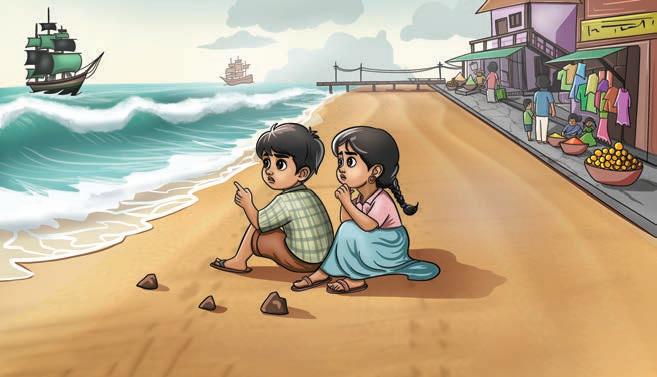
Basava and his sister Sundari sat on the sand, watching the sunrise over the sea. They were waiting for their father’s ship.
‘It’s been so many months,’ Sundari said sadly. ‘Appa has never been away for so long.’
‘Remember the big storm last week?’ Basava said worriedly. ‘I hope Appa’s ship is safe.’
After a while, they saw a ship. As it came closer, the children saw that it had black and green sails.
Their father’s ship had red sails with a flying eagle. They felt sad and went to help their mother.
Basava and Sundari felt when they saw the black and green sail?
She sold vegetables in the market. Sundari liked going to the market. Sailors from different lands came to buy and sell things.
Appa: father in Tamil sails: large pieces of cloth that catch the wind to drive the ship forward sailor: a person who works on the ship

A trader’s wife told Sundari and Basava to ask about their father’s ship at the jetty.
So, Basava and Sundari went to the jetty. There they saw three ships, including the one with the black and green sails. They met a soldier at the jetty.
‘We are looking for a ship from Kamboja,’ Sundari said to him. The soldier pointed to the ship with the black and green sails and said, ‘That ship came from there.’ The children ran to the ship, hoping to find some news about their father. The sailors on that ship did not speak their language.
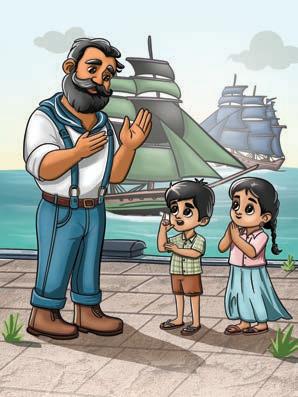
‘Oh no!’ Basava sighed. ‘How do we talk to them?’
‘Easy!’ Sundari grinned. ‘We talk to them like Amma does when they come to buy vegetables.’
What do you think Basava and Sundari should do now?
They went to an old sailor and asked, ‘Kamboja?’ He nodded. Basava pointed to the sail and Sundari’s red skirt, saying, ‘Ship? Red sail?’
The sailor gestured with his hands, mimicking the graceful motion of a bird in flight. Seeing his gestures, the children shouted, ‘Yes! A flying eagle on the sail!’
trader: a person who buys or sells things jetty: a wide stone wall at the shore, where ships and boats stop sighed: let out a deep breath to show sadness Amma: mother in Tamil mimicking: (here) using hand movements to show something

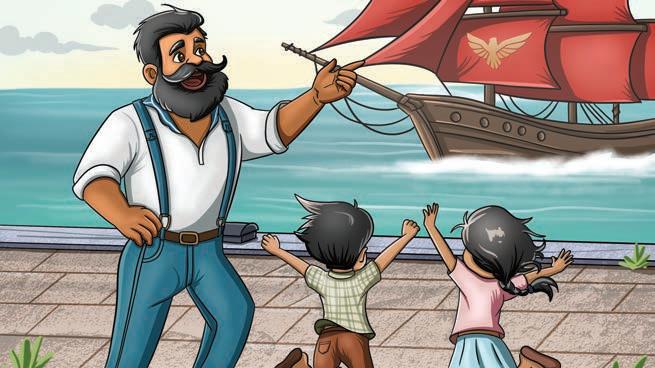
The man took them to the back of the ship and pointed out to the sea. They saw a ship coming closer and closer. Then they saw it—the red sails with a flying eagle. The children clapped and cheered with joy!
‘Your Appa is a sailor?’ the old sailor asked gently.
‘You can speak our language!’ Sundari exclaimed.
‘A little bit,’ the man laughed.
Basava and Sundari felt very happy. Finally, after many weeks, Appa was sailing back home.
‘Feeling blue’ means to feel sad. In the old days, when a captain or an important officer died during a journey, sailors flew a blue flag to tell other ships and show their sorrow. Did You Know?
exclaimed: (here) spoke loudly because of shock

Listen to all the keywords here.


Read and Respond

1. Choose the correct answers.
a How long had Basava and Sundari’s father been away from home?
i several weeks ii many months
iii a few days iv a year
b What did Sundari enjoy about visiting the market?
i seeing sailors from different places ii seeing interesting ships
iii selling vegetables iv watching the sunrise
c What colour were the sails of their father’s ship?
i red with a flying eagle ii black and green
iii blue with a dolphin iv white with stripes
d What did the old sailor at the jetty show the children?
i a map ii his ship
iii the fish he had caught iv their father ’s ship
2. Write True or False.
a Basava and Sundari’s father had never been away for such a long time before.
b The children immediately found their father’s ship with red sails and a flying eagle.
c Sundari did not enjoy visiting the market where her mother sold vegetables.
d Sundari’s mother communicated with the sailors by using her hands to show what she meant.
e The sailor they met at the jetty spoke their language very well.


3. Answer the questions in one or two sentences.
a Describe the places that Basava and Sundari go to in the story.
b Why were Basava and Sundari sitting on the sand at the beginning of the story?
c How did Basava and Sundari feel about their father being away for so long?
d Where did Basava and Sundari go to ask about their father’s ship? What did they find out there?
e Describe how Basava and Sundari communicated with the sailor on the ship from Kamboja.



1. Identify the problem and the solution in the story by answering these questions.
a What is the main problem that Basava and Sundari face in the story?
b What do they do to try and solve their problem?
c How is the problem solved at the end of the story?
2. For each event, choose how Sundari and Basava probably felt.
Hint Box: worried disappointed hopeful delighted
a Watching the sunrise while waiting for their father.
b Remembering the big storm from last week.
c Seeing the ship with the black and green sails.
d Finally, seeing their father’s ship with red sails and a flying eagle.




Think about a time when someone in your family went on a long trip.
a How did you feel while they were away? How did you feel when they came back?
b How was your experience similar or different to Sundari and Basava’s?


Pronounce Well Listen to the words here.

Work with a partner and take turns to read the words aloud. Then, underline the words that make the sound given in the heading. Some have been done for you.
Short a Long A sound
More long A words
Short e Long E sound More long E sounds
mat mate stray fell feel be
plan plane crayon met meet even
sack sake they swept sweep evening
rack rake prey guess geese female
am aim lady bet beat thief
pad paid baby speck speak niece
ran rain break left leaf piece
man main great less least believe
Note: The magic e in words like mate make the short sound in mat long.


Fill in the blanks with correct letters to complete the words. Then, read the sentences aloud.
a The kids played in the s nd at the beach.
b The children were happy to m t new travellers.
c The kids felt s f when they saw their father’s ship.
d One traveller wore a r d hat.
e The ship had black and gr n sails.


Vocabulary
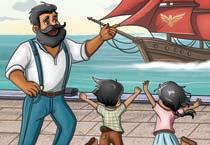
1. These are words related to travel. Match the words and the pictures.
ship
harbour
sailor






life jacket
cruise ship









Then, fill in the blanks with the words.
a Basava’s father is a . He spends most of his time at sea.
b Basava’s father’s faced a storm at sea.
c During the storm, everyone on board had to wear a for safety.
d The ship docked safely in the .
e After their father ’s return, the family decided on a week-long vacation on a .
2. Arrange the following list of words in alphabetical order in your notebook.
shouted sea soldier sand ship sails sell sailor storm safely


Personal Pronouns
Remember!
We use special words in the place of nouns so that we need not repeat the nouns. These words are I, you, he, she, they, we and it. These words are called pronouns.
Personal pronouns can be used in the place of names and of people, animals or things.
I, he, she, we, you, they, and it are personal pronouns.
For example:
Basava and Sundari saw a ship. They were excited. (Here, they is used for Basava and Sundari.)


1. Imagine you are Basava. Fill in the blanks with the correct personal pronouns.
I am Basava. My father is a sailor and hasn’t been home for months. Sundari and I are worried and cannot help thinking about the storm last week. damaged quite a few ships. go down to the harbour and see a ship, but has the wrong sails and are disappointed.
Sundari and I go to the market where my mother works. sells vegetables to sailors from all over. have interesting stories to tell.
Some pronouns show belonging. They come at the end of a sentence and are not followed by a noun. They are used to show that the subject of the sentence owns or has something. Mine, yours, his, hers, theirs, ours and its are possessive pronouns.
For example: This sailor’s cap is mine. (Here, mine is used for Basava’s father.)
2. Write the correct possessive pronouns for the pictures.
a Whose father is this? He is . (theirs/their).
b She is saying the cap is . (her/hers)
c This is her father ’s ship. It is . (his/hers)
d I wish all the gold on the ship were . (myself/mine)
e This boat is . (our/ours)


Listen Well
Listen to the text here.
Listen to the story carefully. Number the sentences in the correct order.
After setting up their tent, they went hiking.
Last summer, Sahil went on a trip to the mountains with his family. Sahil had a wonderful time and couldn’t wait to go on another trip.
First, they packed their bags and got into the car. In the evening, they ate hot chapatis and told stories.
Then, they drove for a few hours and reached the mountains.


Speak Well

Practise speaking here.
Sit in a group of four. Tell your friends about a place you travelled to and what you did there. You can use these clues to help you.
My parents and I went on a trip to Lansdowne last summer. Where? When?
With?
Give details Ending
We We also saw The day/thing I enjoyed most was because I wish that It was a lovely holiday and I was sorry we had to go home but




Use simple words and sentences when talking.
Look at your classmates while you are talking. Show that you are listening to your classmates when they speak.

Write Well
We keep a diary to write about what we do everyday and to express our feelings.
Model Answer
15 June 2025
9 p.m.
Monday
Dear Diary,
Today, I visited the zoo for the first time. I saw so many amazing animals, like lions and elephants. My favourite was the playful monkeys. They were so funny! I had a great time and can’t wait to visit again. I think I want to work with animals one day.
Goodnight, Sahil
Date Time Day
Thoughts and activities Greeting

Name Closure
Write a diary entry about a place you visited. You can use the sentence starters in the box to help you.
Today, I visited...
I saw... I did...
My favourite part was... I felt...








—Santhini Govindan



If you had a magical carpet and could travel anywhere in the world, where would it be and why? Discuss with your friends.
The poet loves to travel but does not want to travel by train or aeroplane. Let’s read the poem and see how the poet wants to travel and where to.


Let’s Read

I want to travel around the world for fun, And see different lands, one by one. But I would not like to travel by aeroplane, train, or by car –I would like to have a magic carpet that will take me afar. I will keep the carpet under my bed, rolled upright, So it will be easy to reach when I want to take a flight. I won’t need to get a passport, or buy a ticket when I want to fly, I’ll just sit on my magic carpet, and wave everyone good-bye!
afar: very far away upright: straight up
passport: a special identity card that allows us to travel to other countries

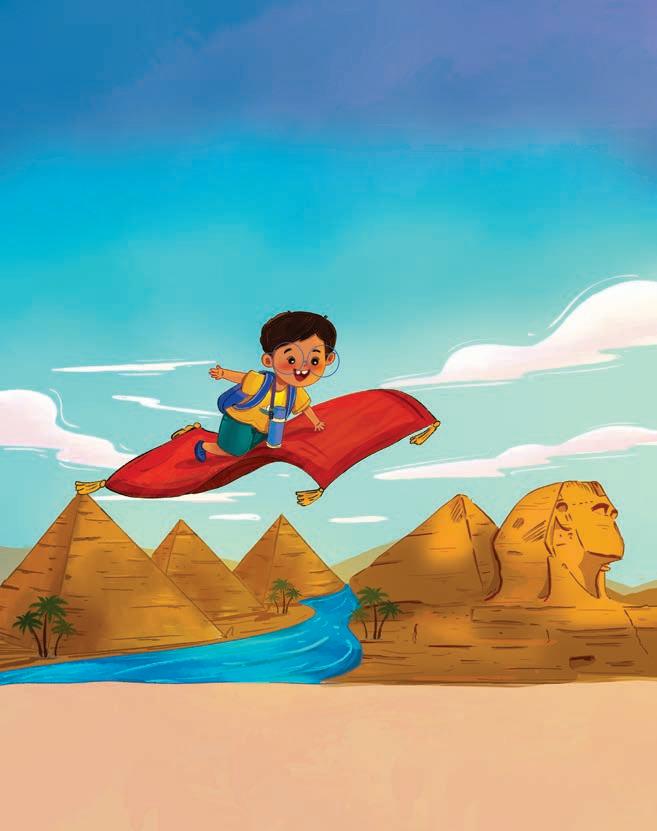
I’ll cross rivers and valleys, and the snowy Himalayas so tall, And fly to faraway China to see the Great Wall. Then I’ll float to Egypt, and visit the great Nile, And see the pyramids, and the Sphinx’s mysterious smile.
I’ll travel to the African jungles where wild animals roam, And visit European cities like London, Paris, and Rome But on my magic carpet, before I eagerly set out, There’s something that I’m a little worried about.
I keep thinking of it, again and again –What will happen if my magic carpet gets caught in the rain?
I’m sure that soaking wet carpets can’t fly far away –So, to travel for fun, I must find another way!

You Know?
In Africa, the five largest and most dangerous animals are: lions, leopards, elephants, rhinoceroses, and Cape buffaloes. They are called the “Big Five”.
mysterious: hard to understand or explain roam: to move freely eagerly: excitedly soaking: completely filled with water
Listen to all the keywords here.
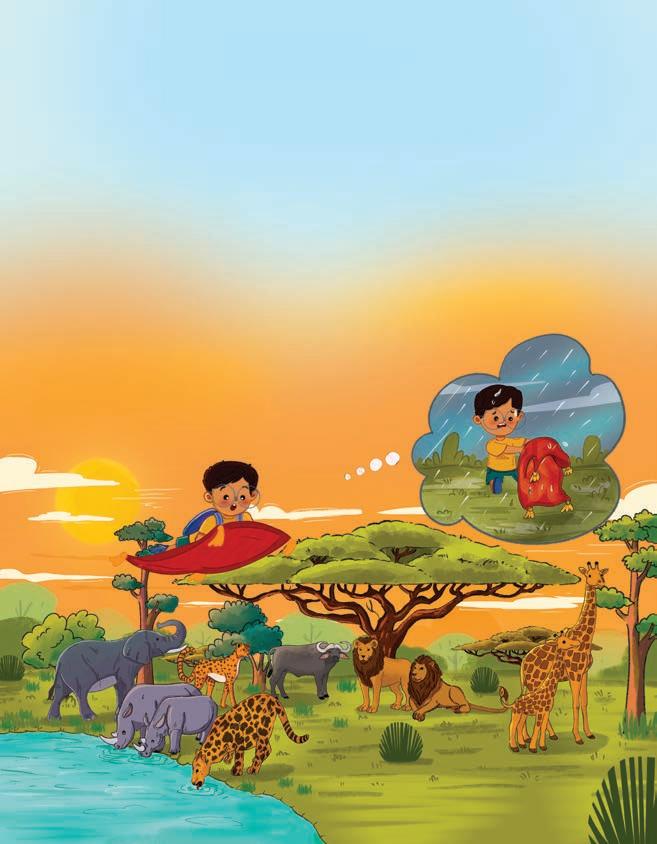





1. Tick () the correct answers.
a How does the boy want to travel around the world?
i By train
ii By magic carpet
b Where does the boy keep the magic carpet?
i In a closet
ii Under the bed
c What does the boy not need if he travels on the carpet?
i A passport
ii His carpet
d Which famous place in China does the boy want to see?
i The Great Wall
ii The Forbidden City
e What is the boy worried about when using the magic carpet?
i It will get lost.
ii It will get caught in the rain.
2. Match the places and what the boy will see there.
Place What the boy will see
Egypt snowy mountains
Europe
China
Himalayas
Africa
the River Nile and the Pyramids
jungles with wild animals
the Great Wall
London, Paris and Rome
3. Answer the questions in one to two sentences.
a Who is ‘I’ in the poem?
b Why does the boy keep the magic carpet rolled up under his bed?
c Why does the boy want to travel by magic carpet?
d Name all the places that the boy sees.
e Explain why a soaking wet carpet cannot fly.
4. Read these lines from the poem and answer the questions. I want to travel around the world for fun, And see different lands, one by one. But I would not like to travel by aeroplane, train, or by car –I would like to have a magic carpet that will take me afar.
a What does the boy want to do?
b How would the boy not want to travel?
c What does the boy wish to have?

Big Idea

You set out on an adventure on your magic carpet! Pack your bag with the most important items you will take with you. Write why you want to take them along.
My Magic Adventure!
For this adventure, I will need:
The first item I need is... because...
The second item I need is... because...
The third item I need is... because... When I go on my magic carpet adventure, I will feel...




1. Match the travel words and the pictures. In your notebook, make sentences with the words.
passport boarding pass
camera luggage taxi
2. Read the words aloud. Write the names in the correct line.
Hint Box:
Land transport
Water transport
Air transport









The mood of a poem is how it makes you feel.
What is the mood of the poem ‘Travel for Fun’?
The mood of the poem is . carefree imaginative playful jovial dreamy
List two lines from the poem that made you choose this word.





You’re going to make a fun Picture Travel Journal to show where you went for your vacation. Whether it’s a trip to a museum, a tourist spot or a visit to your grandparents’ house, share what you saw, what you ate, and the special moments you had.
What you need for the project
• A4-size sheet
• Glue or tape





• Markers, crayons, or coloured pencils
• Scissors
• Photos or drawings of the places you visited
• Stickers or other decorations (optional)
Steps:

• Fold an A4-sheet to make a card. Decorate the front page with the title ‘My Travel Journal’ and your name. You can also draw or add a picture of the places you visited.
• On the inside, write about the places you visited, what you saw and interesting or fun things you did, on one side.
• On the other page, write about the food you ate, new things you tried, your favourite dishes, and how you felt about the trip.
• Paste or draw pictures of your trip in your journal.
• Make your journal colourful by adding doodles, stickers, or decorations.
Finally, present your travel journal in class.






Imagine your friend has broken an arm and was absent from school for a long time. Discuss in class how you would help your friend in the following situations.
Helen Keller was a little girl who fell sick at a young age. Her life changed forever but with time, she became stronger. Today, the story of her courage is known around the world. What did she do, and who helped her? Let us read about Helen Keller’s journey.



Helen Keller and her family lived in a small town in America. She was like any other child and loved to play, laugh, and explore the world around her. When she was almost two years old, she became very ill. She got better, but she could no longer see or hear.
As Helen grew up, she realised that she was different. Her mother taught her to express herself by pointing and nodding or shaking her head. She was a clever child and was always learning new things. At the age of five, she knew how to fold clothes and where to put them. Sometimes, when people spoke, Helen would touch their lips. When she could not understand what they were saying or they did not understand her, she would kick and scream until she was exhausted.
Think and Tell
Why do you think Helen would kick and scream?
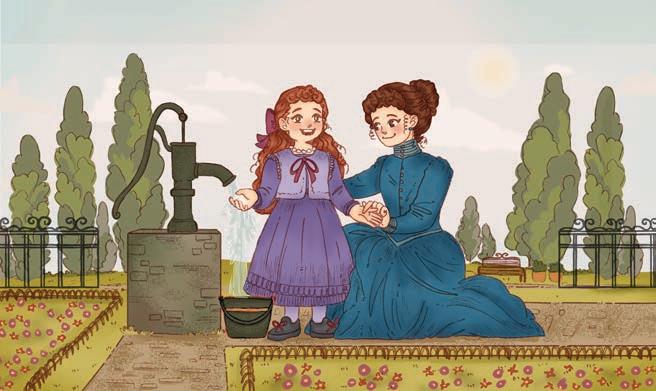
express: say what she thought or wanted to exhausted: very tired

The third of March, 1887, was the most wonderful day of Helen’s life. She met an incredible teacher named Anne Sullivan. Miss Sullivan was kind and patient with Helen and soon she was learning numbers, letters and words. Miss Sullivan started off by using her fingers to spell words on the palm of Helen’s hand. For a long time, Helen did not understand and would pull back her hand or sometimes show anger but Miss Sullivan didn’t give up.
One day, while they were at the water pump, Miss Sullivan spelt ‘W-AT-E-R’ in Helen’s palm while letting water flow over it. Suddenly, Helen understood! She realised that the cool liquid flowing over her hand was called ‘water.’
‘W-A-T-E-R!’ Helen spelt back, a huge smile spreading across her face. Helen was overjoyed! She quickly learnt more words by spelling them out. It was like learning a new secret language. Helen’s family joined in too. ‘Look, Helen, this is a D-O-L-L,’ her mother spelt , handing her a favourite toy. They practised spelling words with Helen every day. They were a team, working together to help Helen understand the world around her.


Sign language is a special way of talking using your hands and fingers to help people who cannot hear. September 23 is celebrated as International Sign Language Day every year. Did You Know?
incredible: extraordinary


When she was eight, Helen started attending the Perkins Institution where she learnt braille, a form of writing that can be read by feeling raised dots on a page. Once she could read, she was taught to speak by Miss Fuller. Now Helen could communicate with other children.
As Helen grew older, she faced many challenges, but she didn’t face them alone. With Miss Sullivan by her side, and with the support of her family, Helen completed school and went to college where she was one of the best students!
Helen became a well-known writer and speaker. She and Miss Sullivan travelled around the world, sharing Helen’s story and making people aware of what blind and deaf people could achieve. Miss Sullivan stayed at Helen’s side for 49 years as her guide and friend
In a note to Miss Sullivan Helen wrote, ‘Dear Teacher, You showed me that alone we can do so little and together we can do so much.’
Did You Know?
Helen Keller became the first person with visual and hearing challenges to get a college degree.
challenges: difficulties or problems achieve: good things they could do
Why was Helen Keller so thankful to Miss Sullivan?
Listen to all the keywords here.



1. Write True or False.
a Helen Keller was born without the ability to see or hear.
b Miss Sullivan was a kind nurse who helped Helen.
c Helen understood the word ‘fire’ the first time Miss Sullivan spelt it on her hand.
d Helen learned to read and write with the help of her family and Miss Sullivan.
e Helen Keller went to college and later became a writer and a speaker.
2. Tick () the correct answers.
a How did Helen’s mother first teach her to express herself?
i By teaching her to read braille. ii By teaching her to speak.
iii By teaching her to point and nod or shake her head.
b What did Helen do when she could not understand what people were saying or when they did not understand her?
i She would touch their lips. ii She would kick and scream.
iii She would write notes to them.
c What message did Helen Keller and Anne Sullivan share with the world?
i Blind and deaf people cannot achieve much.
ii Blind and deaf people can achieve great things.
iii It is impossible to teach someone who is blind and deaf.
3. Answer the questions in one or two sentences.
a What happened to Helen when she was a baby?
b What was Miss Sullivan’s special way of teaching Helen?
c How did Helen’s family help her learn new words?
d What was Helen Keller able to achieve as she grew older?
e What did Helen write in the note to Miss Sullivan?





Read the actions of the people in the story. Then, write what you think Helen thinks or feels.
When people spoke, Helen would touch their lips.
what they are trying to say
Helen thinks about . Miss Sullivan used her fingers to spell words on Helen’s palm.
Helen thinks . Helen would not understand anything and pull back her hand.
Helen feels . Helen writes a letter to Miss Sullivan. Helen feels . Big Idea


Helen, her family and Miss Sullivan teach us the important lesson of teamwork.
Write down a goal you want to achieve in the future. It could be learning a new sport, being more organised with school work or making a new friend. Then, list who can help you reach your goal and how. For example: Goal: Improve my grades in Maths.
People who can help me: My father, My teacher, My grandmother
1. My father can help me practise. He can give me some questions to work on every day and check my progress.
2. My teacher can help me by explaining the concepts again.
3. My grandmother can help me learn my tables.


Pronounce Well
Listen to the words here.
Short vowel sounds are: a in at, e in egg, i in ink, o in hot and u in up.
Long vowel sounds are said like the name of the letter in the alphabet –The A sound in ape, E in see, I in kite, O in old and U in tube.
Read these words aloud.
cat fish bed dog pig cup
kite bake boat team tube feast
If you slowly say a short vowel and a long vowel word, you will be able to notice the difference—mat and mate, set and seat, bit and bite, cot and coat, tub and tube.
Read the words in the box aloud. Then, write them in the correct box.
Hint Box: duty cope kind doll kick upset


Now, complete the sentences with the words in the box.
a Helen hugged her favourite when she was sad.
b Miss Sullivan was very to Helen.
c Helen’s teacher felt it was her to help Helen learn.
d Helen would and scream when she was .
e Helen learnt to with her fears.


There are words that can be used to explain other words. For example: the word ‘fruit’ can be used for apples, oranges watermelons, and plums.
Find one word for the items below.
• car, truck, ship:
• sunny, rainy, windy:
• shirt, jeans, dress:
• square, circle, triangle:
• pen, paper, eraser:
Complete the sentences with the words.
a We should wear clean to school every day.
b I need some new when I go back to school.
c We can use different to make a drawing.
d The smoke from can cause air pollution.
e The is so pleasant today.


Prepositions of time: These words tell us when something happens.
Prepositions of time
Prepositions (Position words) tell us where something is, where it is moving or when something happens.
Meaning Examples at
We use at for the exact time. Our school starts at 8 o’clock. on
We use on for days and dates. I play football on Wednesdays. I will see you on the 3rd of July. in
We use in for months or years. My birthday is in September. I was born in 2016. before
We use before for things that happen first. I will say goodbye before I go. after
We use after for things that happen next. I will see you after the match.
1. Fill in the blanks with the correct preposition of time.
a Miss Sullivan came (in/on) the morning.
b Helen’s mother helped Helen practise her spelling (on/at) noon.
c Her birthday is on 7 June, two days (on/before) mine.
d Helen hugged Miss Sullivan (in/on) her birthday.
e Helen went to college (at/after) school.


Prepositions of place: These words tell where something is placed.
Prepositions of place
Meaning Examples at
We use at to show a specific place. I will meet you at the station. on
We use on to show something touching the top of something else.
The ball is on the table. in
We use in to show that something is inside. My father is in the kitchen. behind
We use behind to show something further back, usually hidden by something.
The mouse is behind the clock, so I cannot see it. under
We use under to show something below another thing.
The dog is under the table.
2. Fill in the blanks with the correct prepositions of place.
a Helen is her library.
b There are many books the shelves.
c The trees are the water pump.
d Miss Sullivan and Helen are the water pump.
e Helen’s hand is the tap.


Prepositions of movement: These words tell us how something moves or in which direction.
Preposition of movement
Meaning up
We use up to show movement to a higher position. down
We use down to show movement to a lower position. around
We use around to show movement in a circular direction. through We use through to show movement from one end to another within something.
3. Match the pictures and the correct prepositions of movement.
Hint Box: Look at the arrows to understand the direction.







Listen Well


Listen to the text here.
Listen carefully to the text and fill in the blanks with the correct words.
Hint Box: water success river trees animals well
a The near the village had dried up.
b Villagers needed water for their crops and .
c The villagers dug channels to bring from another river.
d Some of the villagers built a to collect rainwater.
e The children helped by planting in the village.
f The villagers celebrated the of their teamwork. Practise speaking here.



Sit in groups of four. Share your thoughts on the words ‘Alone we can do so little; together we can do so much’. You may use the sentence starters given below.
Sharing personal experiences:
• Once, when I worked with my friends, we . Expressing ideas and opinions:
• I think teamwork is important because .
• When we help each other, it makes me feel .
Listening to others:
• I agree with what you said about .
Asking questions:
• How did you feel when we worked together?
• Why is it important to help each other?






Listen carefully to the other members and wait for your turn to speak.
Participate and share your ideas.
Use kind words and listen to what others have to say, even if you don’t agree.
Stay on the topic of discussion.

A poster should have three parts: Title, images and a message or a slogan.
Title: Give a title that is catchy and sounds good when it is read.
Images: Draw or paste in pictures on the topic. You may add one big picture or many smaller ones.
Message/Slogan: Write a short sentence or a phrase related to the theme. It should be crisp and catchy. It can include a rhyme.

Form a group of four. Make a poster on ‘Teamwork’.
is Dreamwork






Discuss your ideas in class. Get Set
There are many animals that live in the wild. What can we do to see that these animals are safe?


Many years ago, in a small village, a man-eating tiger started attacking humans. The villagers were helpless and needed someone to protect them. They went to Carpet Sahib for help. Who was Carpet Sahib? What did he do to help the villagers? Let us read the story to find out.


The moon shone brightly over the thick jungle of Nainital as Jim Corbett moved quietly through the bushes. The night was silent, and every sound made Jim’s heart beat faster.
‘Please, Carpet Sahib, you must help us,’ the villagers had begged him earlier that day. ‘The leopard is attacking our people. We are too scared to go outside.’ The villagers trusted Jim and called him Carpet Sahib because they could not say his surname. He knew that a leopard could be dangerous and that he had to help his friends.
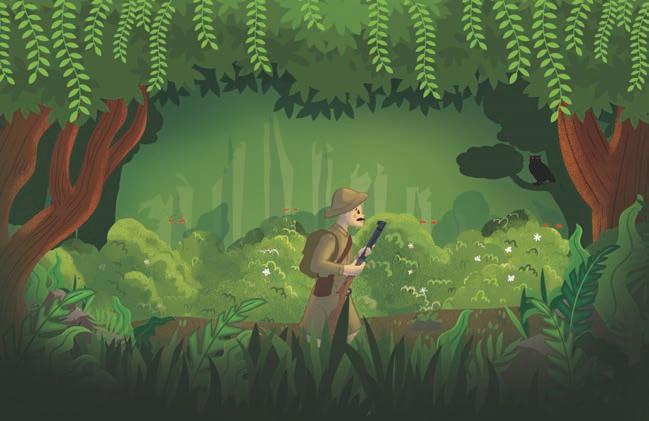

Jim Corbett was a hunter, but he did a lot to protect wildlife in India. He was also a good photographer. He took beautiful photos of wild animals and used them to talk to people about how to care for animals and nature.
begged: asked for something again and again protect: look after and keep safe photographer: person who takes photos
Think and Tell Why did Jim’s heart beat faster?


Jim entered the forest with a guard or two and waited patiently at the spot where the cat was last seen. The thick trees did not let any moonlight through, making it very difficult to see in the darkness. Suddenly, Jim heard it—a low growl that made his heart race. The leopard was close.
Jim and his guards held their guns tightly, listening very carefully. There, in the distance, he saw two glowing eyes. The leopard was watching him. It moved with a limp—the leopard had been hurt. Jim felt sad for the leopard. He realised it might be attacking people because it was very hungry and humans were easy prey.
Jim decided to set a trap to capture the leopard without hurting it. He found a safe spot and put food for the cat inside a cage. Then, he waited again, his heart pounding. The jungle was silent except for the rustle of leaves. Minutes felt like hours. Finally, the leopard came out of the shadows, drawn in by the smell of the food. It walked slowly at first, and then, with a quick move, entered the cage. The door closed behind it.
Jim walked slowly to the cage. ‘It’s okay, my friend,’ he whispered. ‘I am here to help.’
Jim called for the village doctor, and together, they treated the leopard’s injured leg. The villagers watched as Jim gently cared for the big cat. Over time, the leopard got stronger and healthier. When the leopard was well enough, Jim and the villagers released it back into the wild. The leopard looked at Jim one last time, as if saying thank you, before disappearing into the jungle. The villagers were safe again.
growl: a low, angry sound made by an animal made his heart race: made him very excited and scared prey: a person or animal being hunted capture: catch
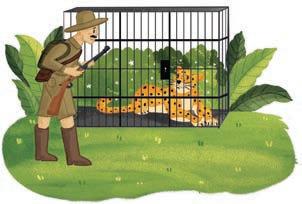
What was the leopard feeling when it looked at Jim for one last time?
his heart pounding: his heart beating very fast
rustle: a soft sound of something moving treated: gave care and help injured: hurt
released: to let something go free
Jim then spent even more time in the village teaching the villagers about animals and helping them understand the jungle and its creatures. Jim showed them how to stay safe and live peacefully with the wildlife around them.
To keep the villagers and animals safe, he built a high wall around the village of Chhoti Haldwani. This wall kept the tigers and leopards away from the village. The wall is still there today.
Wherever he went, Jim taught children why it is important to protect nature and wild animals. His good work led to the creation of India’s first national park, now called the Jim Corbett National Park. This park is home to many tigers and other animals that now live safely in the jungle. Through his actions and teachings, Jim Corbett showed that the villagers and wild animals could live together in peace.


peacefully: without trouble
wildlife: animals living in nature creation: making or building
National Park: an area that a country sets aside to protect nature and wildlife
The Jim Corbett National Park is in the state of Uttarakhand, India. It was opened in 1936 and is the oldest national park in India.
Listen to all the keywords here.





1. Fill in the blanks with the words in the box.
Hint Box: leopard trap protect injured wall
a Jim Corbett went into the jungle to the villagers.
b Jim set up a with food inside to capture the leopard.
c The had a hurt leg.
d Jim and the village doctor treated the leopard’s leg.
e Jim built a high around the village to keep the leopards away.
2. Number the events of the story, 1–5, in the correct order.
a They treat the leopard and look after it until it is well.
b Jim and his helpers find the leopard and see it is hurt.
c They set the leopard free in the forest.
d The villagers ask for help, as a leopard is attacking people.
e Jim decides to set a trap for the leopard.
3. Answer the questions in one or two sentences.
a Why did the villagers call Jim Corbett ‘Carpet Sahib’?
b How did Jim and the guards know that the leopard was close?
c Why did the leopard start catching people instead of animals?
d Why did Jim spend more time in the village after they released the leopard?
e What was India’s first national park called? Why was it created?





Answer the questions.
a Find another expression in the text that means almost the same as, ‘Jim’s heart beat faster’.
b Choose one sentence that shows that Jim really cares about the leopard.
c Write the words from the passage that show that the leopard did not get better quickly.
d How would you describe the look that the leopard gives Jim when they release it?
It gave Jim a look.


In India, there are more than three hundred types of animals that are endangered. As a student, write what can you do at your school and at home to protect these animals?
Some of India’s endangered animals:


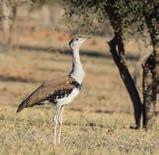



Pronounce Well

Read these words aloud.
ch words with a /ch/ sound
chop chip
chain chest
cheese lunch
Listen to the words here.
ch words with a /k/ sound
ache chorus echo stomach school character
Look at the ch-words in the sentences. Write ch or k based on the sound. Then, read the sentences aloud.
a The baby birds chirp loudly when their stomachs are empty.
b There is chaos when this angry elephant charges through the forest.
c Our school wins every choir competition.
d Your chest aches when you have a cough.
e The ship’s anchor was tied to a chain.


1. There are some words that usually go together. Match these pairs and then say them aloud.
endangered tricks
animal fire
national animals
monkey pond
duck kingdom
forest park
In your notebook, make three sentences with any of the word pairs you matched.
2. Look at the pictures. Fill in the prefixes re- or un- to complete the words. Make sentences with each word in your notebook.
A prefix is a group of letters added to the beginning of a word to change its meaning. For example: tidy- untidy; use-reuse


3. Complete the sentences by adding a suffix from the box to the words in brackets.
Hint Box: -ess -ful -less -ness -ly -ers
a Rangers are the of animals. (protect)
b Rangers can give people information. (help)
c The actions of people can harm animals. (care)
d The zookeeper handles the animals . (safe)
e A female lion is called a . (lion)
f We should show to animals. (kind)

Grammar

The Simple Present Tense
• We use the simple present tense to talk about things that happen every day. These can be habits. For example: The rangers pump water every morning.
Remember!
We use different forms of doing words (verbs) to show the time things happen.
• There are also things that are true all the time. In such sentences, we always use the simple form of the doing word (verb). For example: Cows are mammals.
Don’t forget that the simple form of the verb may need -s or -es.
Action done by
He (Ankit)
She (Anu)
Form of doing word (verb)
It (The moon) is -s or -es form of the verb

Examples of facts that are always true
Ankit is a boy. Anju is a girl. The moon shines at night.
Action done by
You (One or more)
We (Anu and I)
Form of doing word (verb)
They (Reptiles) are simple form of the verb
Examples of facts that are always true
You are from India. (one) You are all from India. Anu and I are from Raipur. Frogs and crocodiles are reptiles. Reptiles have scales.
Owls catch their prey at night.
I am am simple verb I am a girl. I belong to the human race.
The Present Continuous Tense
• The present continuous tense is used to show that actions are happening or continue at the time of speaking.
Here, is, are and am are helping verbs. The main verb takes -ing.
Look, the bird is building a nest!
We use the is/are/am + ing form of the verb.
For example:
The rangers are busy pumping water for the animals.
1. A. Underline the verbs in the sentences to see how they are different. Write (SP) if the sentence is in the simple present and (PC) if the sentence is in the present continuous tense.
a The sun usually shines during the day. The sun is shining at the moment.
b Is the earth moving around the sun now? The earth moves around the sun.
c There are rules in the Jim Corbett National Park. The people in that car are breaking the rules!
d Metu, why aren’t you reading the rules?
I always study the rules given at the park gate.


B. Write what you noticed about the verbs in each tense. How are they different?
2. Look at the picture and fill in the correct form of the verbs in brackets.
a The jaguar (watch) its prey.
b Look, it (sit) very still.
c Jaguars (be) the third biggest cat after tigers and lions.
d You (see) them mostly in the Amazon jungle.
e Their numbers (decrease) because people keep on (cut) down trees in the forest.


Listen Well
Listen to the text here.
Listen to the passage carefully. Tick () the correct answers.
a Where did the sea turtles lay their eggs?
i In the ocean ii On the beach iii In the forest
b What problem did the turtles face?
i There were too many people on the beach.
ii There was a lot of garbage on the beach.
iii There were many birds on the beach.
c Who decided to help the turtles?
i The parents ii The children iii The fishermen
d What did the children do to help the turtles?
i They built nests for the turtles.
ii They cleaned up the beach.
iii They moved the eggs to a different place.
e How did the children’s efforts help the turtles?
i The turtles could lay their eggs safely.
ii The turtles found new homes.
iii The baby turtles stayed out of the sea.




Practise speaking here.
Interview a person in your community, like a vet, a farmer, or someone who knows a lot about or helps birds and other animals.
• Step 1: Decide who you will talk to.
• Step 2: Write down the questions you will ask. Some ideas have been given below.
• Step 3: Remember to introduce yourself and thank the person at the end.
• Step 4: You can record the interview so that you can play it to your classmates. Remember to first ask the person you interview for their permission to record what is said.
How to start:
Good morning, Dr Jai. Thank you for speaking to me.
Hi Uncle Raj, I am doing a school task and I think you know a lot about birds.
May I please ask you a few questions?
Some interview questions:
When did your interest in animals start?
How long have you been ….?
What is the most interesting thing you have done?




How to end:
Thank you for your time.
Thanks for answering my questions.
I look forward to sharing what I learnt with my classmates.


We write an invitation to ask someone to come to an event. An invitation has five sections:
• Event Name: What is the name of your event?
• Date and Time: When and at what time is the event?
• Location: Where is your event?
• Details: What activities will there be? Add any specific details that you want to share.
• You may add an image to make your invitation catchy.
Model Answer Invitation
Date: Saturday, 15 July 2025
Time: 2–4 p.m.
Where: Central School Hall
Join us for a talk by Dr Rambani of the Wildlife Society to learn more about this interesting topic.
No bats, no chocolate!
Invite friends and their parents to a tree-planting event in a nearby park. Give your invitation a heading and use the correct format.



Get Set

Write one thing you are thankful to receive from each of these farm animals.
1. Cows: I am thankful for
the milk they give us
2. Sheep: I am thankful for
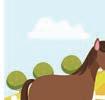
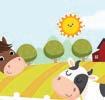
3. Goats: I am thankful for
4. Bees: I am thankful for

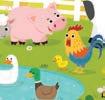


Cows are beautiful, friendly animals. But the poet loves the cow for some special reasons. Let us read to find out what these are!


Let’s Read

The friendly cow, all red and white, I love with all my heart: She gives me cream with all her might, To eat with apple tart.
She wanders lowing here and there, And yet she cannot stray, All in the pleasant open air, The pleasant light of day; And blown by all the winds that pass And wet with all the showers, She walks among the meadow grass And eats the meadow flowers.
and Tell
How do you think the cow feels while walking among the meadow grass?
cream: the thick layer that forms on top of the milk when it is boiled might: strength
tart: a type of pastry that is hard on the outside and soft on the inside wanders: walks around without any specific place to go lowing: makes a deep, mooing sound stray: move away from the right place or path pleasant: nice and enjoyable meadow: a grassy field with flowers
Apart from cream, what else does a cow give us?
Cows cannot bite you because they do not have front teeth at the top. Did You Know?
Listen to all the keywords here.

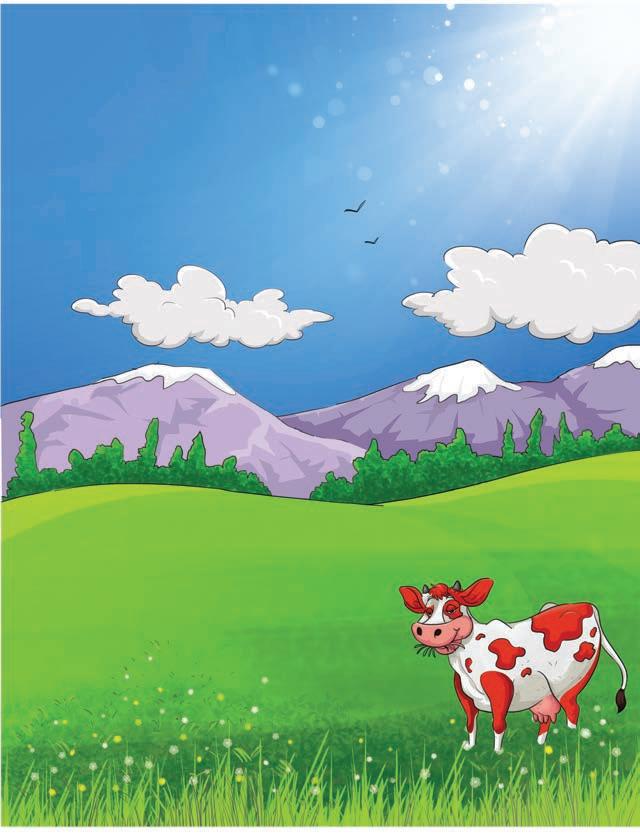


Read and Respond

1. Complete the summary of the poem with the words/phrases in the box.
Hint Box: wanders open air friendly stray meadow grass
The cow is . She gives cream. She around lowing but does not far. She enjoys the and light of day. She walks among the .
2. Match the lines from the poem and their meaning.
The friendly cow, all red and white
She gives me cream with all her might
She wanders lowing here and there
All in the pleasant open air
She walks among the meadow grass and eats the meadow flowers
The cow roams around making soft noises.
The cow is outside in the fresh air.
The cow is red and white.
The cow wanders through the grass and eats flowers.
The cow gives a lot of cream.
3. Answer the questions in one or two sentences.
a What does the cow enjoy eating?
b Do you think the speaker loves the cow? How do you know?
c How does the cow help the speaker?
d Why do you think the cow roams in the meadow?
e What does it mean when the speaker says the cow ‘cannot stray’?




Idea
This poem is about the beauty of nature. What are your favourite things in nature? Fill in the table.


Vocabulary

flowers
1. Fill in the blanks with the correct prefixes to form words that show how we can care for and protect animals.
a We should (courage) children to respect wildlife. i en- ii dis- iii re-

b It ’s important to (cycle) plastic to keep the rivers and the sea clean.
i pre-
ii re-
iii de-
c We must (vent) actions that can harm animals, like starting fires.
i un-
ii pre-
iii mis-
d We must not be (patient) with animals.
i im-
ii in-
iii un-
e Hunting and killing animals causes an (balance) in nature.
i dis
ii im
iii un
2. Add a suffix (-ness/-ful) to each word to make a new word.



In your notebook, use the words to make sentences about caring for or protecting animals.
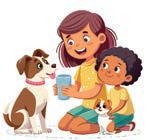
Fill in these details about your favourite animal, and try making your own poem!
What is your favourite animal?
What colour is your favourite animal?
What sound does your favourite animal make?
What does your favourite animal do?
What else can your favourite animal do?
What do you love about your favourite animal? kind help happy care thank


Now make the poem! Sing your poem to a tune in class.
The , all , I love with all my heart, It makes me so happy, To see it around. It all day, And it also , It sounds like a , Just look at it play!
(another action) (sound)
(Two more lines about what you love about your favourite animal) (favourite animal) (colour) (action of the animal)




Get Set

Match the information about the birds and their pictures.
Name and Description
A magpie is a black, white and blue bird with a long tail.
A thrush is a brown bird with spots on its chest.
A blackbird is an all-black bird with a bright yellow beak.
A turtle dove is a small bird with a reddish-brown feathers.
A starling is a dark, shiny bird with spotted feathers.

The birds decided they needed nests, but they didn’t know how to build them. They went to Magpie for help. Let us read the story to find out how Magpie helped the birds.




Once upon a time, all the birds wanted to learn how to build nests. They went to the cleverest bird, the magpie, and asked her to teach them. The magpie agreed and gathered all the birds around her.
First, the magpie took some mud and made a round shape with it.
‘Oh, so that’s how it’s done!’ said the thrush. The thrush flew away and that’s how thrushes build their nests now.
Next, the magpie added some twigs around the mud.
cleverest: the smartest gathered: called or collected


‘Now I know how to do it,’ said the blackbird, and off he went. Blackbirds have been building their nests this way ever since.
Then, the magpie put another layer of mud over the twigs.
‘Oh, that’s easy!’ said the wise owl, and away he flew. Since then, owls have been making their nests this way.
After that, the magpie wrapped twigs around the outside of the nest.
‘That’s perfect!’ said the sparrow, and off he flew. Sparrows make rather messy twig nests, but this is how they still do it.
Finally, the magpie added some feathers and soft material inside the nest to make it comfortable.
‘That’s just right for me,’ said the starling, and off he flew. Starlings have cosy nests because of this.

Magpies are called ‘clever’ because they can solve puzzles, use tools and understand other magpies. They are very smart birds!
What kind of nests do owls make?
layer: a thin covering of something that is spread over something else wrapped: covered something by putting something around it
material: what you use to make something with comfortable: nice and cosy cosy: soft and warm
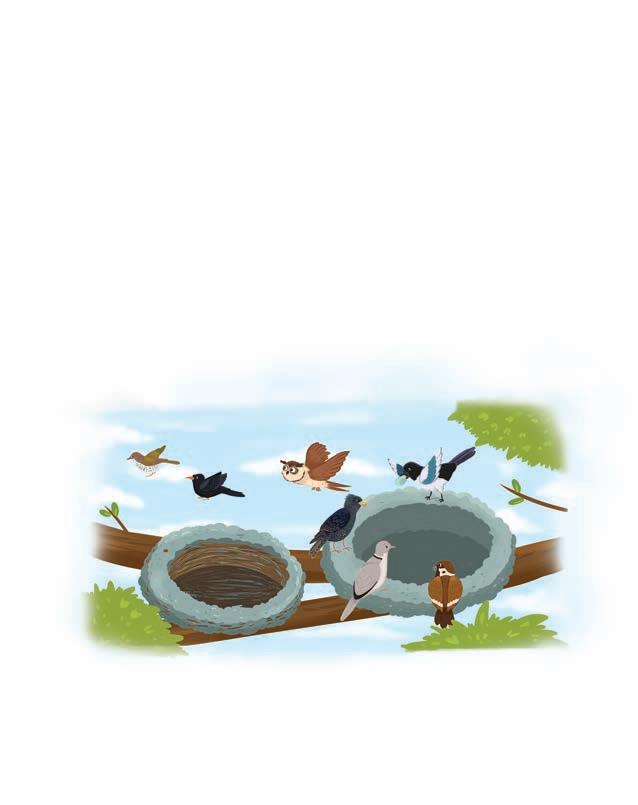


One by one, each bird learned a little bit and then flew away. No bird stayed until the end to see the whole process. Only the turtle-dove remained, but she was not paying attention. She kept repeating her silly cry, ‘Take two, Taffy, take two-o-o-o.’
The magpie was busy and heard this just as she was adding a last twig to the nest. She said, ‘One’s enough.’
But the turtle-dove kept saying, ‘Take two, Taffy, take two-o-o-o.’
The magpie was annoyed and said, ‘One’s enough, I tell you! There isn’t place for more.’
Still, the turtle-dove kept repeating, ‘Take two, Taffy, take two-o-o-o.’
Finally, the magpie looked up and saw that all the other birds, except the silly turtle dove, had flown away. She got very angry and flew away too, refusing to teach the birds any more.
And that is why different birds build their nests in different ways.
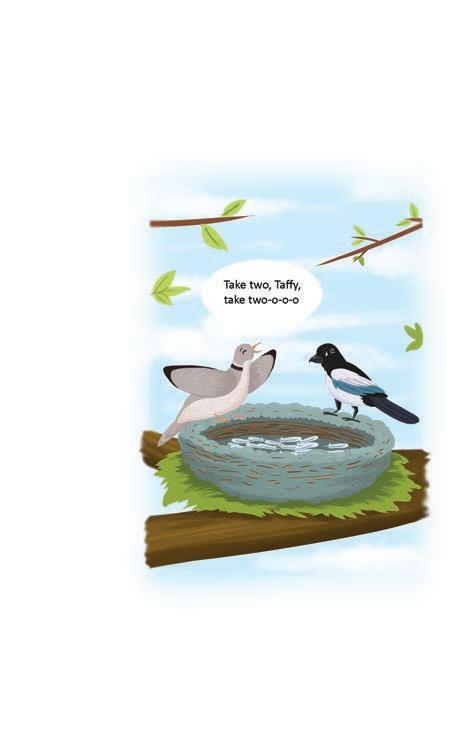
process: the steps to make or do something cry: a sound of a bird enough: as much as needed annoyed: upset or irritated except: not counting something as a part of group or team refusing: saying no to someone
Why did the magpie refuse to teach the birds any more?
Listen to all the keywords here.



1. Match the birds and how the story says they build their nests.
Birds Nests
Thrush feathers and soft things inside
Blackbird messy twig nests
Starling mud and twig nests
Sparrow mud nests
2. Fill in the blanks.
Hint Box: clever owl thrush soft nests
a The magpie agreed to teach the birds how to build .
b They asked the magpie because they thought she was .
c The flew away and was the first to go and build a nest.
d The said that building a nest was easy.
e It is the materials inside a nest that make it comfortable.
3. Answer the questions in one to two sentences.
a Give three facts that show that magpies are smart birds.
b What problem did the birds face? How did they solve it?
c Why do starlings have cosy nests?
d What did the magpie think ‘Take two, Taffy, take two-o-o-o’ meant?
e Name two things that made the magpie angry.



What do you think would have happened if the birds had all stayed for the Magpie’s full lesson?
a What would the nests have looked like?
b Would this have been a good thing or a bad thing? Give two reasons for your answer.





The magpie is a very interesting bird! Watch the birds near your house and fill in this information sheet about one bird.

The bird is called .
The bird’s feathers are colour.
Draw what its beak looks like.
The bird’s eyes are . (colour)
The bird lives in .
The bird eats . I saw it do these interesting things: 1. 2. 3.


Draw and colour in the bird.
Listen to the words here.
Read the words aloud without saying the underlined letters. Silent k Silent w Silent b Silent l Silent t know write climb talk listen knit wrong bomb walk catch knock wrap lamb calf watch knot wriggle thumb half match kneel wrist crumb yolk often

2. Fill in the blanks with the correct letters. Then, read the sentences aloud.
a The yo of the egg feeds the chick as it grows in the egg.
b The bird flew to ca ch a worm.
c The bird ate the bread cru .
d The woodpecker ocks on the tree trunk.
e The worm iggled when the bird picked it up.


Vocabulary

Contractions
We can use an apostrophe (‘) to make shortened forms of words. These are called contractions.
Look at how the apostrophe is used in the place of the letters and spaces that are left out.
For example:
• I do not see a bird, do you?
• You are not even looking.
I don’t see the bird, do you? You aren’t even looking.
1. Write the words these contractions are made of.
a isn’t b there’s
c didn’t d you’re
e can’t f they’re
g musn’t h we’ll
i wasn’t j I’ll


2. Fill in the blanks with the correct contractions.
a The magpie said, ‘ teach you how to make a nest.’
b ‘ hard to build a nest,’ she said.
c The birds stay for the whole lesson.
d It long before the birds were all building their own nests.
e ‘ a silly bird,’ said the magpie to the dove.


Phrases are groups of words that do not make complete sense. gather around The birds gathered around the magpie.
This does not make complete sense. This makes complete sense.
Verbs (doing words) can combine with other words like prepositions (position words). We call these phrasal verbs. For example: Let’s gather around the table. Here, gather is a verb and around is a preposition. It means to come together.
1. Underline the phrasal verbs in the sentences. Then, match the phrasal verbs and their meanings.
a The magpie looked for twigs for her nest. relied on
b The birds set up a meeting with the magpie. understood
c Each bird must look after its own nest. searched
d The owl figured out how to build a nest. arranged
e The birds counted on the magpie for help. take care of
When verbs take -ed at the end to show an action in the past we call them regular verbs.
For example:
Remember!
Verbs (doing words or action verbs) show us when an action happens.
The birds ask the magpie to help them. (Simple present)
The birds asked the magpie to help them. (Simple past)
Here ask + ed shows that the action was done in the past.
Irregular verbs change completely in the past tense.
For example:
The birds go to the magpie for help. (Simple present)
The birds went to the magpie for help. (Simple past)
Can you find more irregular verbs in the story?
2. Write the past tense form of the underlined verbs. Use a dictionary to check your spelling.
Present tense verbs Past tense verbs
a The bird taps against the window.
b I wrap the little bird in a soft cloth.
c It dips its beak in the water.
d I hum to myself.
e The bird flaps its wings. What did you notice about the spelling?
3. Fill in the past tense forms of the verbs. Write ‘R’ for regular verbs and ‘IR’ for irregular verbs.
a All the birds (hope) the magpie would help them.
b They (feel) she was the right one to ask.

c When she (begin) the lesson they listened carefully.
d The birds (form) a circle around the magpie.
e The magpie was cross when she (find) that they had left.
4. Rewrite the sentences using the past tense forms of the verbs.
a No bird stays till the end.
b Only the turtle-dove remains.
c Why does the turtle dove repeat the same silly call?
d The birds dream of having their own nests.
e The magpie feels angry.


Listen Well

Listen to the text here.
Listen to the text Interesting Facts About Birds carefully and write if the sentences are True or False.
a Penguins can fly very high in the sky.
b Eagles have excellent eyesight.
c Parrots are known for their dull colours.
d Hummingbirds can hover in one place by flapping their wings very quickly.
e Birds use their feet to eat different kinds of food, like seeds, insects and nectar.
f Each bird has its own special song that it uses to communicate with others.



Practise speaking here. Speak Well
Imagine that you and your class visited the Bharatpur Bird Sanctuary. Work in a group and take turns to describe what you saw and what you did there.


Use expressive words like curious, delighted and gigantic to make your description interesting. Look at your friends as you speak.




Sit in a group of five. Read the information about what makes a good story.

Setting:
The setting is where and when the story takes place.
Characters:
The characters are the people or animals in the story.
Beginning:
The beginning of the story tells us where, when and who. It introduces the characters and the setting.
Middle:
The main events form the middle of the story. The characters face problems or go on adventures. What is the problem in this story?
End:
The end is how the story finishes. It tells us how the characters solve the problem or what happens after the adventure.
Use this information to work together and plan your story. Write your story in your notebook.
. Wind on the Hill —A A Milne

Get Set

List five things that you see moving when a strong wind blows. Share your list in class.
We all love the wind because it cools us down. When the wind blows, there is a feeling of excitement in the air. But where does the wind go? Let’s read the poem to find out.


Let’s Read

No one can tell me, Nobody knows, Where the wind comes from, Where the wind goes.
It’s flying from somewhere As fast as it can, I couldn’t keep up with it, Not if I ran.
But if I stopped holding The string of my kite, It would blow with the wind For a day and a night.
And then when I found it, Wherever it blew, I should know that the wind Had been going there too.
So then I could tell them Where the wind goes... But where the wind comes from Nobody knows.
Think and Tell Who is ‘I’ in the poem?
keep up with: (here) try to match the speed of the wind
Think and Tell
Where do you think the wind comes from?
Listen to all the keywords here.

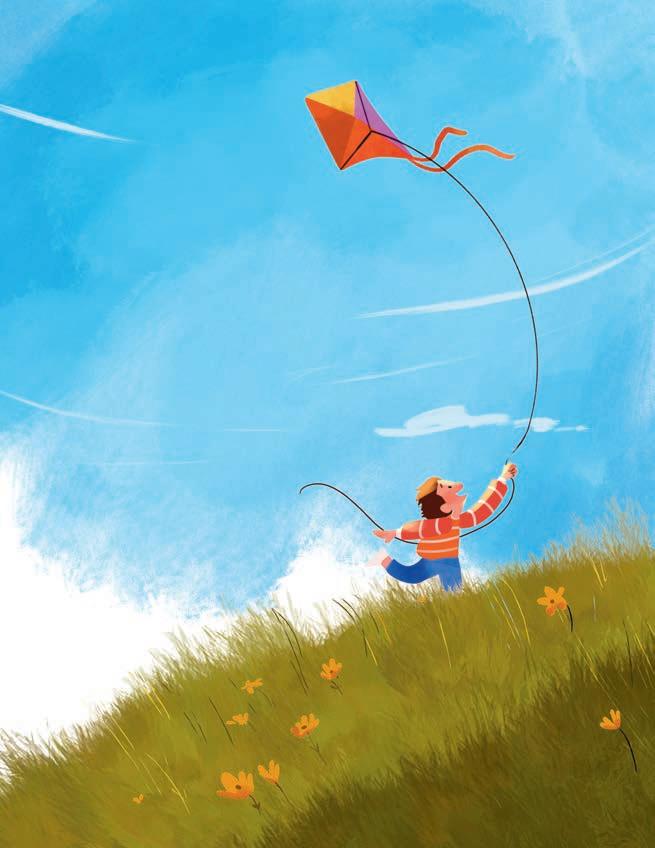



1. Tick () the correct answers.
a Where does the wind come from?
i We don’t know where. ii The mountains
iii The ocean
b How fast does the wind blow?
i Slowly ii Not too fast iii As fast as it can
c What will happen if the speaker lets go of the kite string?
i The wind will stop blowing.
ii The kite will fly away.
iii The kite will come down.
d How long will the kite fly if the poet lets it go?
i For a few minutes.
ii For a whole day and night.
iii It won’t fly at all.
2. Write True or False.
a The poem says that nobody knows where the wind goes.
b The speaker can keep up with the wind by running.
c The kite will blow away if the speaker lets go of the string.
d The wind has gone wherever the kite blew.
3. Answer the questions in two to three sentences.
a Which lines tell us that the speaker has asked people where the wind comes from and where it goes?
b What would happen to the kite if the wind stopped blowing?
c What do you think will happen if there are very strong winds?
d How does the speaker think he can find out where the wind goes?



Big Idea

Keep track of the wind for a day. Fill in this table after observing the wind carefully.
Time of Day Morning Afternoon Evening
Wind strength (circle)
Ways in which the wind helps me and my family
Ways in which the wind troubles me and my family

Vocabulary

• No wind
• A little windy
• Very windy
• No wind
• A little windy
• Very windy
• No wind
• A little windy
• Very windy

There are many words that sound the same but mean different things. These words are called homophones.
1. Look at the pictures and circle the correct spelling of the word shown in the picture.

2. Choose the correct homophones to complete the sentences.
a The river flows down to the . (see/sea)
b The hopped quickly across the meadow. (hare/hair)
c We found a small in the ground where the rats might be hiding. (hole/whole)
d The cat is over , near the tree. (there/their)
e The wind very strongly. (blue/blew)



Poems and stories have a setting. A setting is where the events take place.
1. Describe the setting of the poem.

2. Close your eyes. Ask your partner to read the poem to you. What do you see? Describe what you imagine in three to four sentences.





You are going to plant a sapling at home in a small pot and create a picture guide to show how you did it. Your guidebook will include step-by-step instructions with pictures on how to plant a sapling and how to take care of it.
Materials Needed:
• A small pot
• A sapling
• Your English notebook
• Glue or tape
Instructions to plant the sapling
• Potting soil
• A watering can or a cup

• Markers, crayons or coloured pencils
• A camera or a phone (to take pictures)
• Take an empty pot. It should have a small hole at the bottom.
• Fill the pot halfway with soil.
• Place the sapling in the centre of the soil and cover the roots with more soil.
• Sprinkle water on the soil to make it damp. Take care not to make it too wet. Plants need water to grow, but too much water can spoil the roots.
• Place your sapling in a sunny and airy spot.
• Water your plant whenever the soil feels dry.
• Watch your plant grow and take care of it every day. Take pictures of each step.



• In your notebook, give a heading, ‘How to Plant and Care for a Sapling’ and your name. You can draw or add a picture of your plant.
• Use the pictures you took of each step. Paste them in your notebook.

• Write short and simple instructions next to each picture, explaining what to do in that step.
• Decorate your guide with drawings, stickers, or any other decorations you like.






Get Set

We have all read stories about magic places. Close your eyes and think about a magical place you would like to be. What will it look like? Who will be there and what will you see?
Draw/write about your magic place.
(Draw/write here)
Alice sees a talking rabbit and follows it into a new world full of adventures. Does such a world really exist or is it her imagination? Let us read to find out.


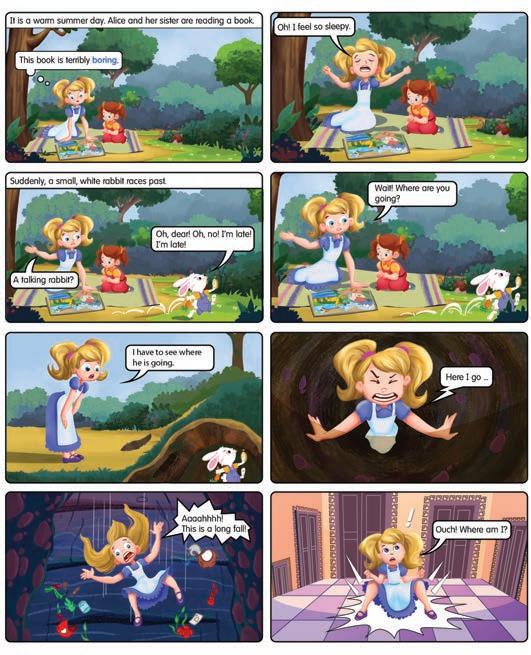
boring: not interesting
Think and Tell
If you were Alice, what would you do after falling down the tunnel?


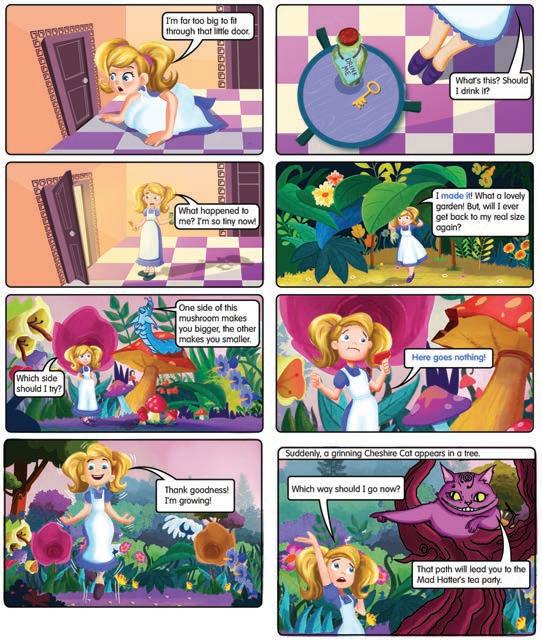
Think and Tell
Why does Alice decide to drink the liquid in the bottle?
Wonderland made it: reached somewhere here goes nothing: something you can say when you try something without being sure what will happen
Alice
Who did not want Alice at the tea party? Why?

no room: not enough space squeeze in: try to fit in a small place strangest: very odd and surprising in a way we may find hard to understand field: a large, open, grassy piece of land croquet: a field game where players use sticks called mallets to hit balls through small metal hoops stuck in the grass chop off: to cut something off using a sharp tool
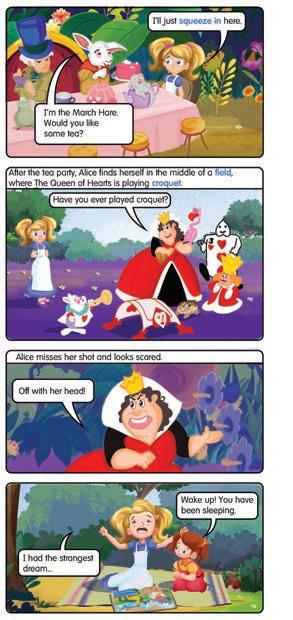
Why was the Queen of Hearts angry with Alice?
Listen to all the keywords here.





1. Complete the summary of the story with the words in the box.
Hint Box: hole wonderland sister tea party Queen of Hearts talking rabbit
Alice saw a . She followed it into the rabbit . She drank something from a bottle and became smaller. She went through the small door and into a . She attended a and met the . It was all a dream and she was woken up by her .
2. Rewrite one main event that happened at the beginning, middle and end of the story.
a Beginning . b Middle .
c End .
3. Answer the questions in two to three sentences.
a What does the talking rabbit say while running past Alice?
b Why do you think Alice decided to follow the white rabbit down the rabbit hole?
c How do you think Alice felt when she realised she had grown smaller after drinking from the bottle?
d Do you think Alice enjoyed the tea party with the Mad Hatter and the March Hare? How do you know?
e At what part of the dream did Alice finally wake up?



1. Complete the table with the solutions to the problems in the story.
Alice found a door that she was too small to pass through.
Alice became too small and wanted to become bigger.
The Mad Hatter told Alice there was no place for her at the table.
2. Tick () how Alice feels at these times.
Event
How does Alice feel?
When she sees the talking rabbit. a curious b scared c bored
When she takes a bite of the mushroom.
happy b curious c nervous
When the Mad Hatter sees Alice. a confused b relaxed c angry
When she meets the Queen of Hearts. a happy b nervous c relieved
When she wakes up from her dream. a excited b relieved c upset




When we use our imagination, we can think of wonderful things that may or may not exist in the real world. Fill in this table with three things that are both in the real world and in Wonderland, and three things that are only in Wonderland.
What is in both the real world and in Wonderland?
What is only in Wonderland?


Similes compare two different things using ‘like’ or ‘as.’ They help make descriptions more interesting. For example: The cat was as quiet as a mouse.
1. Underline the simile in each sentence. Circle the person or thing the simile describes.
a Alice felt as light as a feather as she floated down.
b The dormouse snored like a bear.
c The rabbit ran as fast as the wind.
d The Cheshire’s cat was as big as a pumpkin.
e The tea at the Mad Hatter ’s party was like honey.
Homographs are words that are spelled the same but have different meanings and are sometimes even said differently. For example:
Homograph
Meanings
Rose a flower the past tense of ‘rise’
2. Match the homographs, in the middle column, with both its meanings. a character in the alphabet a device to tell time right moving water on the sea a message written to someone on paper bat something that is correct a flying mammal
letter
watch to look at something to move your hand back and forth
A stick used to hit a ball a direction
wave




Punctuation marks are symbols we use in writing to make the meaning clear and show how to read sentences.
Capitalisation
Capitalisation is the use of a big letter (capital letter) at the beginning of a word.
First word in a sentence. This is a cat.
Names of people, places and specific things. Riya, Sam, India, Taj Mahal
Days of the week and months of the year Monday, January
The word ‘I’ My friend and I will have fun.
Titles of books, movies, and songs The Lion King
Full Stop (.)
It is used at the end of sentences. For example: Alice had a dream.
Question mark (?)
It is used at the end of a question. For example: Where is the rabbit going?
Exclamation mark (!)
It is used to show strong feelings. For example: Wow! This place is beautiful.
Comma (,)
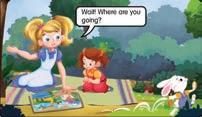
It is used to list more than one of something in a sentence. For example: I have apples, mangoes, oranges and bananas.
1. Rewrite the sentences using the correct punctuation marks and capital letters.
a Alice saw a white rabbit It was wearing a coat
b ‘I’m late I’m late’ exclaimed the rabbit
c Alice met the caterpillar the march hare the mad hatter and the queen of hearts.
d ‘Wait Where are you going’ Alice asked the rabbit
e The queen of hearts was playing croquet with a flamingo and a hedgehog
We use the simple future tense to talk about an action that will happen in the future (tomorrow, next week, next month, next year).
We add will before the verb to talk about actions that have not happened yet.
For example:
The drink will help me fit through the door.
(Here, the drink is not helping Alice right now, but it will help her later.)
2. Fill in the blanks with simple future forms of verbs.
a I (go) where the rabbit goes.
b Alice (drink) from this bottle.
c A bite from the other side (make) you smaller.
d The Queen (have) some tea.
e You (let) the Queen win.


3. Correct and rewrite the sentences to describe actions that will happen in the future.
a Everyone will enjoys the tea party.
b The flamingo will spoiling Alice’s game.
c Alice will misses a shot.
d Alice will passing through a tiny door.
e The Dormouse will sleeps till tea.


Listen to the text here.
Listen carefully to the text and fill in the blanks with the words in the box.
Hint Box:
musical instrument mother hen giant’s castle axe beans beanstalk
a Jack lived with his .
b Jack exchanged the cow for five magic .
c A giant grew outside Jack’s house.
d Jack climbed the beanstalk and saw a .
e Jack took a golden and a that laid golden eggs.
f Jack cut down the beanstalk with an .




Speak Well
Sit in a group of four. Perform a role play.
Step 1: Choose a story that your group likes.
Practise speaking here.
Step 2: Decide on a scene from the story that your group likes.
Step 3: Write what each character says (dialogue).
Step 4: Learn your lines and practise together.
Step 5: Enact the scene.


Speak clearly, so everyone can hear you.
You should change your voice to match what you are saying. You should move your hands and arms to show actions, like waving or pointing.
Let your group members finish their lines before you speak.
You may use costumes for your roleplay.




A dialogue is when characters in a story talk to each other. It’s the words they say.
To write a dialogue, we need to remember four things:
1. Speaker Tags: Write the name of the character/speaker.
2. Natural Speech: Write dialogue that sounds like speech and not written language.
3. Characterisation: In brackets, write how the words should be spoken.
For example:
Queen of Hearts (angrily): Off with her head!
Paul and Amala have found a magic key in their garden. Write the dialogue between them.
Paul: (shouts) Hey Amala, come here. Look what I found.
Amala: (whispers) It looks like a .
Paul: Let’s
Amala: (excited)
Paul:
Amala: (nervous)



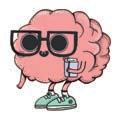


1. Think about a time when you were upset with someone. What did you do in this situation?
2. Sometimes our actions upset other people and make them angry. Think about a time when that happened. How did you calm that person down?
Discuss in pairs and share your thoughts with your classmates.
Tenali Ramakrishna is loved by everyone in King Krishnadevaraya’s court.
But, one day, King Krishnadevaraya becomes upset with Tenali. What did he do to upset the king? Does Tenali find his way back to the king’s court?
Let us read the story to find out.




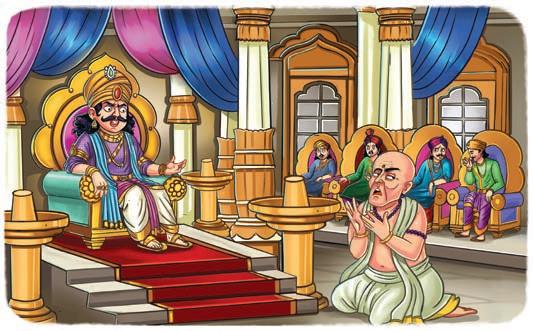
Once upon a time in the kingdom of Vijayanagara, there lived a clever and funny poet named Tenali Ramakrishna. King Sri Krishnadevaraya and his courtiers respected him for his smart thinking. Most people loved Tenali, but there was a chief priest who did not like him at all. He was jealous of Tenali and would look for reasons to belittle Tenali. One day, he hatched a plan to make Tenali Ramakrishna look bad in front of the king. He went to the palace to talk to the king.
Why do you think the chief priest was jealous of Tenali Ramakrishna?
courtiers: people who help and work with a king or queen chief priest: the head of a religious group jealous: being upset because someone else has something that we want but do not have belittle: to make someone feel they are not important hatched a plan: made a plan
Chief Priest: Your Majesty, I have terrible news! Tenali Ramakrishna has been telling everyone that you have a secret collection of pink elephants and you sleep with a garland of flowers around your neck!
King: (angrily) What? How dare he! Bring him to me at once!
Tenali Ramakrishna is brought to the court.
King: (shouting) Never show me your face again, or I will lock you up in prison!
Tenali: (shocked) But, your majesty, what did I…?
King: Enough! I do not want to listen to anything you have to say. You must follow my orders.
Tenali tried to explain, but the king was too angry to listen. Sad and confused, Rama left the court.
Days passed, and the court felt dull without Tenali’s jokes and wisdom. The courtiers missed his clever remarks. One day, as they were discussing something important, they saw someone with a pot on his head sneaking around the palace gardens.
Minister 1: Who is that? Is that Tenali?
Minister 2: Impossible! He would not dare.
They tried to catch this mysterious person, but he was too quick and was
garland: a string of flowers how dare he: an expression of anger at something someone has done dull: boring wisdom: the ability to make good and smart decisions

remarks: things that someone says sneaking: moving quietly so that nobody can see or hear impossible: something that cannot happen mysterious: something strange and unknown which makes one curious


gone before they could reach him. The ministers were left confused and a little amused.
Another day, the king himself saw the person with a pot on his head while taking a walk in the royal gardens.
King: Who is that? Why is there someone with a pot on their head in my garden?
The guards tried hard to catch the man, but they failed every time. They realised the man was really clever.
A few days later, the courtiers found out that the chief priest had lied to the king. They hurried to inform him.
King: ( looking guilty ) What have I done? ( talking to the guards ) Bring Tenali Ramakrishna back at once!
Think and Tell Who do you think this mysterious person could be?
Tenali Rama was a real person who lived several hundred years ago. He did not go to school as a child, but he learnt from a wise teacher who taught him stories and wisdom.
To the king’s surprise, Tenali Rama entered the court with a large pot covering his head. The courtiers giggled.
King: Why have you covered your face with a pot, Rama?
Tenali: (voice echoing from inside the pot) Your majesty, as a loyal citizen of Vijayanagara, it is my duty to follow your orders. You asked me never to show my face, but I could not stay away from my royal duties. So, I used this pot to hide my face from you but still do my work.
amused: feeling entertained and happy because something is funny
hurried: rushed or ran quickly
guilty: feeling bad knowing that one is wrong
echoing: a sound that repeats itself
loyal: being a good friend or member of a group
royal: something to do with a king
King: (laughing) Only you, Tenali, could come up with something so clever! Remove the pot, my friend.
Tenali removed the pot, smiling. The king hugged him warmly.
King: I am sorry I was unfair. I should have listened to you.
Tenali: Your majesty, all is forgiven. After all, it is not every day that I get to see the king make such a grand mistake!
And so, Tenali Ramakrishna was back at court, and the chief priest never tried to trick the king again.
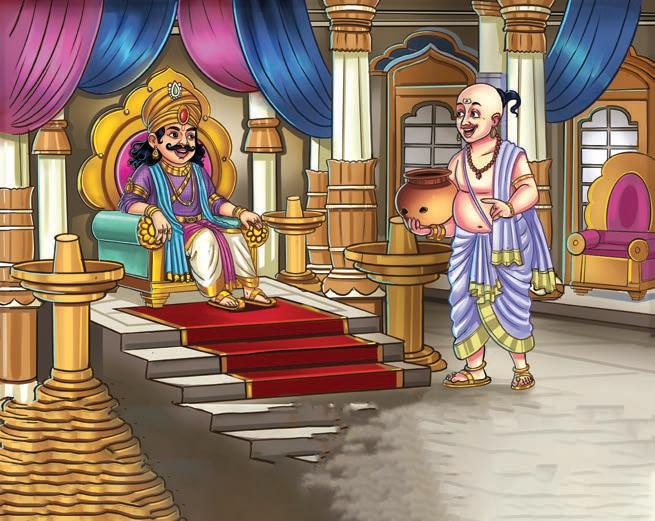
forgiven: not being angry about what someone has done grand: something big that can not be missed
Listen to all the keywords here.





1. Match the characters and their actions in the story. The chief priest The King
discussed important matters.
wore a pot on his head.
The ministers
Tenali Ramakrishna
2. Tick () the correct answers.
shouted at Tenali.
lied to the king.
a Who was the clever poet in Vijayanagara?
i The Chief Priest ii Tenali Ramakrishna iii The King
b Why was the chief priest unhappy?
i He was jealous of Tenali.
ii He did not like the king.
iii He wanted to be a poet.
c What did the king order Tenali Ramakrishna to do?
i He asked Tenali Rama to leave the kingdom.
ii He asked him never to show his face again.
iii He told him to write a poem.
d How did Tenali Ramakrishna solve the problem of not showing his face?
i He wore a mask.
ii He covered his head with a pot.
iii He stayed at home.
3. Answer the questions in two to three sentences.
a What did the priest tell the king? How did the king react?
b How did Tenali follow the king’s orders but still do his work?
c Why was the court dull without Tenali?
d Why did people laugh when they saw Tenali with a pot on his head?
e How did the king feel at the beginning of the story? How did he feel when he knew the truth?


Think and Answer

1. Retell the story ‘The Pot Face’ in your own words. What did he do? The priest was jealous so he
Next, The king
Then, Tenali
But, The courtiers
Finally, The king
2. Compare Tenali and the priest. Write their actions and what each action tells us about them. You can use some of the words in the box.


Who is a better person, Tanali or the priest?
I say so because

Big Idea

Tenali solves many problems in the kingdom. Do you think there are problems around us that also have to be solved? Think about your home, your community, or your school. Complete the table with a problem and solution.
Problem 1
Problem sentence No street lights.
Where is it happening? My community.
Who does it affect?
What is the solution?

People living in the area.
People who live there should complain to the local authorities.

Pronounce Well
Problem 2
Listen to the words here.
We can break words into small parts called syllables. A syllable usually has one vowel (a, e, i, o, u) sound.
an/gri/ly (here, ‘ly’ ends with an ‘i’ sound)

Say the words aloud. Write the number of syllables in each word.
Word Number of syllables
Word Number of syllables
man elephant
garland ministers wisdom garden

Vocabulary

Compound words are words that are formed by combining two simpler words to create a new word with a specific meaning. For example: sun + set = sunset
1. Look at the pictures and write the compound words.







An anagram is a word or phrase formed by rearranging the letters of another word or phrase. The new word must use each letter only once. For example: listen silent
2. Rearrange the letters to write a new word. The picture will give you a clue.
post
save
















Words that tell us more about actions (verbs) are called adverbs.
They tell us how the action is being done. We add -ly at the end of a word to make an adverb.
For example:
The courtiers laughed loudly. How did the courtiers laugh? loudly (loudly tells us about the verb ‘laugh’)
The king hugged him warmly. How did the king hug him? warmly (warmly tells us about the verb ‘hug’)
Sometimes, we remove or change the last letter before adding -ly.
• If the word ends with -y, we change it to i and then add -ly.
For example: happy – The children were playing happily.
• If the word ends with -le, we remove -le and add -ly.
For example: horrible – I am horribly dirty.
• The last letter can also double up.
For example: final – He finally came home.
1. Change the underlined words to adverbs.
a Tenali spoke clever.
b He looked at the priest cunning.
c Tenali left the palace sad.
d He thought of an idea quick.
e The king spoke angry.
2. Fill in the blanks with the -ly forms of the word.
a The chief priest behaved (bad).
b The king was treated (royal).

c Tenali moved around (mysterious) in the garden.
d The guards left (immediate).
e (surprising), the king asked Tenali to leave his court.


Listen to the text and fill in the table.
Who are the main characters?
Where does the story take place?
What do the characters try to find?
Listen to the text here.
Do they succeed? How do you know?



Practise speaking here.
In a debate, two or more people talk about a topic. They say if they agree or disagree with a topic and give reasons.
Sit in pairs. Choose one of the topics given below. Discuss with your partner whether you agree or disagree with the topic.
• Maths is the most important subject in school.
• Each student should do at least two kinds of sport.

• Art and music should be given more time in school.

You can use the following sentence starters when agreeing with an idea:
I agree because
I feel the same way because
Yes, I think that
That’s a good idea because
You are right because
You can use the following sentence starters when disagreeing with an idea:
I disagree because
I think you are wrong because

No, I don’t think that
I see it differently because
I don’t agree because

Pay attention to what your partner says.
Don’t interrupt when someone else is speaking. Give reasons why you agree or disagree. It is good to give examples as well.




A paragraph has the following parts:
• Topic Sentence: Here we introduce the main idea of the paragraph.
• Supporting Details: These sentences provide details and examples that support the topic sentence.

Topic sentence Concluding lines Supporting details
• Concluding Sentence: This is the last sentence of the paragraph that gives a final thought or summary.
Model Answer
My Favourite Animal
I think dogs make the best pets.
Dogs are very friendly and loyal. They have soft fur that makes them nice to cuddle. Dogs also have a good sense of smell that helps them find things.
I love dogs because they are playful and fun. Dogs are amazing pets!
Write a paragraph on ‘My Favourite Comedy Show.’
Topic sentence Supporting details Concluding lines Topic





In class, share what happened one morning when you were late for school. Give the reason why you were late. Get Set
Imagine a morning where everything seems to go wrong. The poem tells the story of a girl who wakes up late and rushes to school, only to be surprised. What could have happened? Let us read to find out.


Let’s Read

I woke up this morning, I climbed out of bed. I put on my clothes and a hat on my head.
I went to the kitchen to look for some food. I let out a yawn, then I sleepily chewed.
I picked up my books and my lunch and a snack and managed to stuff it all into my pack.
I walked out the front door and wandered to school, and, wow, did I feel like the world’s biggest fool.
The lights were all off and the doors were all locked, and I was embarrassed; a little bit shocked.
I looked at my watch and, indeed, it was eight. But I’d overslept. I was twelve hours late.
Think and Tell
How did the girl feel while eating breakfast?
stuff: to push and fit into a small space wandered: walked in a very relaxed way embarrassed: felt shy or ashamed
Think and Tell
Why was the girl embarrassed? Listen to all the keywords here.

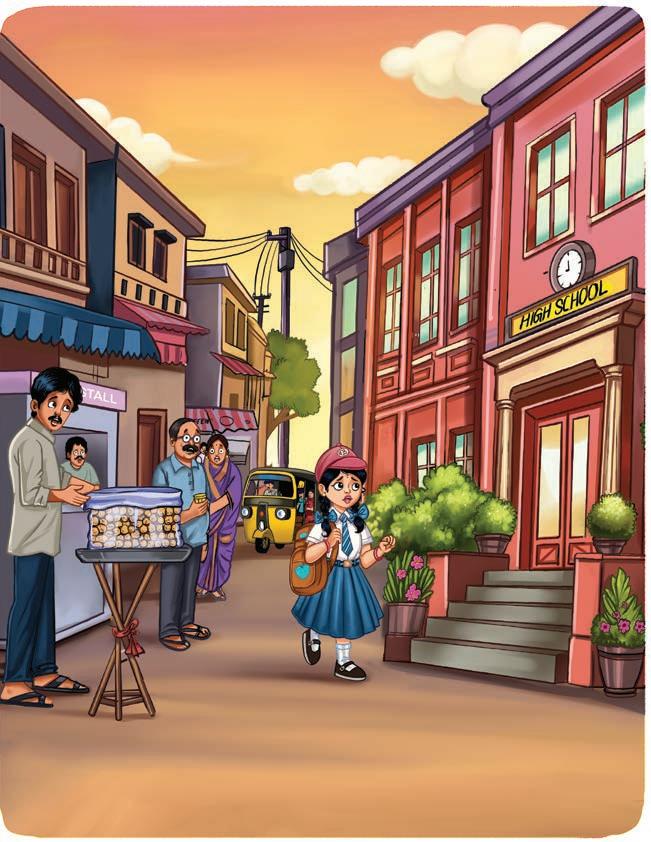


Read and Respond

1. Write True or False.
a The girl put on a hat after getting dressed.
b The girl packed her books, lunch and a snack into her pack.
c The girl felt very confident and happy while walking to school.
d When the girl reached her school, the lights were on and the doors were open.
e The girl looked at her watch and realised she was twelve hours late.
2. Imagine you are the girl in the poem. Complete the sentences with the words from the poem to retell what happened.
I woke up this morning and got out of bed. I put on my and a hat on my head. I went to the to look for some food and yawned. I managed to stuff all my things into my . I left home and wandered to . When I arrived, the were all off and the doors were locked! I must say, I was embarrassed and a little bit shocked. I looked at my and realised it was eight o’clock. I’d and was twelve hours late.
3. Answer the questions in one to two sentences.
a What items did the girl stuff into her pack?
b Use your own words to describe how the girl walked to school.
c Why did the girl feel like ‘the world’s biggest fool’?
d What did she realise after looking at her watch?




Everyone makes silly mistakes from time to time, and it’s okay. It could be something as silly as forgetting to wear the correct uniform or mixing up school days.
Share a funny or silly mistake you made recently. You may use one of the ideas below or think of your own.
1. Have you ever put something in the wrong place and had a difficult time finding it?
2. Can you think of a time when you made a mistake that made everyone laugh?
3. What silly thing have you done that you still remember?
Then in class, discuss how making mistakes is a normal part of life and how everyone learns from them.


1. Read the words from the poem. Match the words that rhyme. bed chewed food shocked locked snack eight head pack late
2. Read the poem. Then, use rhyming words to add your own lines to the poem.
Squeaky the squirrel loved to play, He danced and pranced every day. He wore a hat that was too big, And tried to dance a silly jig.

Squeaky’s hat was so big, . He loved to dance, to move and sway. .
3. Match the words and their meanings. to giggle a statement or story meant to make people laugh a fool a trick played on someone a joke to act in a playful or stupid way be silly to laugh quietly and often uncontrollably a prank a person who acts in a way that will make people laugh



Imagery is when words are used to create pictures in your mind. It helps you imagine what things look like, smell like, sound like, taste like or feel like.

Sit in pairs. Read the poem I Woke Up This Morning to each other. Close your eyes and visualise the poem. Complete the table.




Let’s create a class joke book filled with laughter! Your funny jokes will make everyone smile and brighten up the classroom.
Materials Needed:
• A small notebook or a diary
• Markers, crayons, or coloured pencils
• Stickers, doodles or other kinds of decoration
Steps

• Think of a theme for your jokes. It could be about animals, school, food, or anything that makes you laugh!
• Write three to five jokes for your book. You can think of a guiding question to create a joke or a funny event in your life. For example:
• Q: Why did the student eat his homework?
A: Because the teacher said it was a piece of cake!
• Q: What do you call a bear with no teeth?
A: A gummy bear!
• As a class, divide the roles of who will be compiling all the jokes in the book, who will decorate the joke book, who will design the front and back cover of the book.
• Add drawings, funny pictures, or decorations to your joke book.
• Make a cover page with the title ‘My Joke Book’ and your class.
Keep the joke book on your class’s bookshelf/teacher desk. You may read it to your friends when they are sad or distressed.

You may ask for help from your teachers or elders.
Work on the joke book as a team. You may decide on a date when you will show the book to your teachers.






How would you help people if you found a large amount of treasure? Get Set
Get ready for an exciting adventure with Momotaro, the Peach Boy! This story from Japan is full of magic, bravery, and fun. Let us read and find out what amazing things happen in the story.




A long time ago, there lived an old man and an old woman. One day, the old man went to the mountains to cut grass. The old woman went to the stream to wash clothes. While she was washing, something big came tumbling down the stream. The old woman was very curious. She pulled it out of the water with a piece of bamboo.
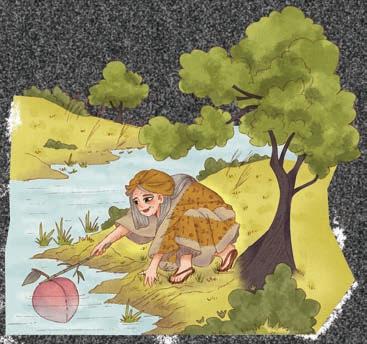
When she looked closely, she saw that it was a very large peach. She quickly finished her washing and went home. She planned to share the peach with her husband.
When she cut the peach in half, a child came out of the large seed! The old couple were overjoyed. They named the child Momotaro, which means Little Peach Boy. They took good care of him, and he grew up to be strong and adventurous.

Every summer in Japan, people celebrate the Momotaro festival. Sometimes people also dress up as Momotaro.
tumbling: falling and rolling around curious: wanting to know more about something overjoyed: very happy
Why did the old man and woman name the baby Momotaro?
adventurous: used to describe someone who likes exploring unknown places and trying new things
As Momotaro grew up, he heard many stories about a faraway island where scary giants lived. These giants had stolen many treasures and kept them on their island. Momotaro wanted to help the people who had lost their treasures. He decided to go to the island of the giants, and bring the stolen treasures back home. He talked to his parents about his plan. The parents were surprised, but they were also very proud of Momotaro for wanting to help other people. They made him some dumplings for his journey. Momotaro put the dumplings in his pouch and set out.
When he started his journey, a dog came up to him and asked, ‘Momotaro, what do you have hanging from your belt?’ Momotaro replied, ‘I have some of the best Japanese millet dumplings here.’

‘Give me one, and I will go with you,’ said the dog. So, Momotaro gave the dog a dumpling. Then a monkey came and got a dumpling in the same way. A pheasant also flew by and said, ‘Give me a dumpling too, and I will go with you.’ So, all three animals went along with him. Soon, they arrived at the island of the giants.

In a lot of cultures, dumplings are considered a symbol of wealth and luck because of their shape.
treasures: valuable and special items dumplings: small balls of dough filled with vegetables or meat and steamed
Which three animals did Momotaro meet on his way to the island?
set out: to leave on a journey millet: a type of grain that is used to make porridge and bread

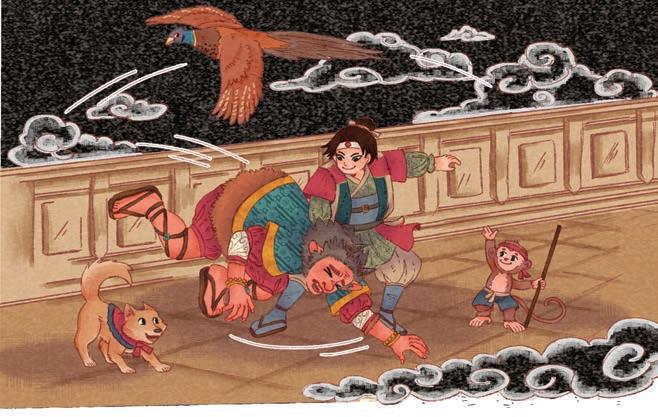
They broke through the front gate, with Momotaro leading and his three friends following. They met many giants who tried to stop them, but Momotaro and his friends fought their way to the chief of the giants, Akandoji. Akandoji was tough but they fought until Momotaro defeated Akandoji. Akandoji agreed to give up all his treasures. After gathering a huge pile of precious things, Momotaro loaded them up and set off for home. He was happy and proud of his success and thanked his three friends.
How would you feel if you had to fight Akandoji? Would you like to be alone or have some friends with you during the fight?
The old man and the old woman were overjoyed when Momotaro returned. They had a big feast. Momataro shared stories of his adventures, and showed everyone the treasures. And so, the Little Peach Boy became a very important and respected man. defeated: beaten by someone precious: very special and valuable

How did Momotaro’s parents feel when he came back? Why?
Listen to all the keywords here.


Read and Respond

1. Fill in the blanks with the correct answers.
Hint Box: pheasant Akandoji peach giants Momotaro
a The old woman found a large in the stream.
b The child who came out of the peach was named .
c Momotaro decided to go to the island of the .
d Momotaro’s three friends were a dog, a monkey, and a .
e The chief of the giants was called .
2. Number the events, 1 to 6, in the order they happened in the story.
a Momotaro fights Akandoji.
b She takes the peach home, and finds a boy inside it.
c Momotaro returns home with the treasures.
d Momotaro sets off to find the treasure.
e An old woman finds a peach in the stream.
f Momotaro meets a dog, a monkey and a pheasant.
3. Answer the questions in one to two sentences.
a What are the places where the events of the story happen?
b How did Momotaro learn about the island of the giants? What did he learn?
c How did Momotaro’s parents feel about his plan to go to the island of the giants?
d Describe the actions that took place on the island of giants.
e How did the family celebrate Momataro’s return?





1. What do the events tell you about the characters? Tick () the correct option.
Event
The old woman pulls the large peach out of the stream.
The giants stole the treasures and kept them on their island.
Momotaro decides to go to the island of the giants to get back the stolen treasures.
What it tells me about the character
This shows that the old woman is .
a hungry
b curious
c kind
This shows that the giants are .
a greedy and terrifying
b kind and powerful
c protective and caring
This shows that Momotaro is .
a lazy and selfish
b brave and selfless
c selfish and courageous
2. Match the events that happened in the story and their effect.
Event Effect
The old woman finds a large peach in the stream.
Momotaro shares his decision to go to the island of giants.
Momotaro gives a millet dumpling each to a dog, a monkey and a pheasant.
Momotaro fights the chief of the giants, Akandoji, and defeats him.
Momotaro brings the stolen treasures home.
Momotaro gets loyal friends and helpers.
The family found a child, and named him Momotaro.
The family is worried, but they support Momotaro’s good cause.


Think of a story that you have read where one of the characters is a giant/a beast. For example: Beauty and the Beast
Complete the table.
Name the story: .
Name the main characters: .
List the things that are similar or different in your story and Momotaro, the Peach Boy. . . . .



When talking about the similarities and differences, you can talk about the place, the problem, and the nature/behaviour of the characters.

Pronounce Well
Read the words aloud.
Listen to the words here.


Fill in the blanks with the correct words. Then, read the sentences aloud.
a Momotaro found a magic .
(clue: it flies in the sky and rhymes with ‘site’)
b Momotaro likes to eat dumplings made of .
(clue: it rhymes with ‘nice’)
c Together, they crossed a river.
(clue: opposite of narrow and rhymes with ‘side’)
d Momotaro and his friends got home at .
(clue: rhymes with ‘sight’)
e Momotaro’s parents were scared that he might .
(clue: an end of line and rhymes with ‘lie’)

Vocabulary

Idioms are phrases that mean something different from what the words actually say. We use them to express ideas in a colourful way.
For example:
Momotaro has the heart of a lion.
Literal meaning
Meaning of the idiom
Momotaro’s heart is the same as a lion’s heart. Momotaro is brave.
1. Match the idioms and their meanings. Then, complete the sentences with the correct idiom. on top of the world something amazing or wonderful out of this world feeling very happy carry the world on very different from each other one’s shoulder the world is your oyster to carry a lot of responsibility worlds apart you can do anything you want
a Momotaro seems to ; he has taken the responsibility to bring back the treasures.
b After winning the battle, Momotaro felt .
c Momotaro’s parents told him that he could be anything he wanted to be! Remember, .
d The treasures on the island of giants were .
e Although Momotaro and the animals were friends, they were in how they looked.
2. In your notebook, write the sentences where the words have been used in the story. Then, write your own sentences using the words.
a overjoyed
c treasures


b adventurous
d defeated
Conjunctions are joining words. We use conjunctions like and, or, but and so to join two sentences. and It is used to join two words or two sentences.
Momotaro was brave and courageous. Momotaro fought the giant and defeated it. or It is used to give a choice. Will Momotaro go in a boat or swim to the island of giants? but It is used to join sentences with opposite meanings.
Momotaro's parents were afraid but they agreed to let him go. so It is used when one thing is the reason for the other.
The old woman wanted to wash the clothes, so she went to the stream.


1. Fill in the blanks with the joining words and/but/so/or.
a The old woman was very curious, she pulled the big peach out of the water.
b She quickly finished her washing went home.
c Momotaro was very strong, he was not arrogant.
d Momotaro wanted to help the people, he went to the island of the giants.
e He could ask the dog monkey to help.
2. Join the sentences using or, and, so or but.
a Momotaro can eat dumplings. Momotaro can eat peaches.
b They met many of the giants’ helpers. They were looking for Akandoji.
c Momotaro fought for the treasures. Momotaro took them home.
d Momotaro gave the dog a dumpling. The dog went with him.
e Akandoji attacked Momotaro with an iron club. Momotaro dodged him.


Listen Well
Listen to the text here.
Listen carefully to the riddles and write the correct answers.



Try to connect the riddle with an object around you.
You may ask the teacher to repeat the riddles and pause between riddles for you to think.

Well
Practise speaking here.
Sit in pairs. Think of a story and narrate it to your partner.
Step 1:
To create a story, we need to think about the following:
• Characters – Who is the story about?
• Setting – Where does the story happen?
• Beginning – Think about how the story starts.
• Middle (Problem or adventure) – Think about what happens in the story. It can be a problem or an adventure. Think about what happens next.
• End – Give a proper closing to say what happened in the end. How was the problem solved?
Step 2: Narrate your story to your partner using gestures (hand movements) and facial expressions.


Speak clearly so that your partner can hear you.
Maintain eye contact when you narrate the story.
Speak slowly and don't rush. Take your time to tell your story.




Instructions are a set of steps or directions that tell someone how to do something or how to complete a task.
Title: Say what the instructions are for.
Materials Needed: List everything needed to complete the task.
Steps: Write detailed actions/steps to be taken in order to do the task. The steps need to be clear, crisp and in the right order.
You may use words like first, then, next, after that and finally.
Visuals (optional): Pictures or diagrams that help to illustrate the steps.
Tips or Warnings: Additional information to help avoid mistakes or to ensure safety.
Model Answer
Materials Needed
• 1 sheet of paper (any colour)
Steps:
• First, fold the paper in half.
• Then, fold the top corners down to meet the centre fold. This will form a triangle at the top of the paper with a rectangle at the bottom.
• Next, pull the sides out and press them flat.
• Now, fold the front and back up.
• After that, pull the two sides apart gently to open up the paper.






• Next, adjust the folds and shape of the boat to make sure it looks like a boat and has good balance.
• Finally, place your paper boat on the water and watch it float!
Warning: Be careful not to tear the paper.
Write the instructions on ‘How to Make an Ice-cream Sundae’.


You may follow the steps with an adult at home.
Take pictures of all the materials and steps to make your instructions visually appealing.

Parent’s Name Criteria: • Mark Green for Can Do • Mark Orange for Getting There • Mark Blue for Needs Help
Student’s Name Teacher’s Name
Middle of the year End of the year
Beginning of the year
Date
Learning Outcomes
Listening
Listens to texts with attention to comprehend key details
Understands and follows complex steps and instructions Focusses on the speaker or activity for 15–20 minutes
Speaking
Describes people, objects, experiences, and emotions in detail
Participates confidently in discussions and conversations Expresses ideas and thoughts using complete sentences Uses grade-level vocabulary accurately when speaking
Reading
Reads aloud fluently with appropriate pauses, intonation and expression
Understands and interprets stories/poems/plays read
Answers comprehension questions with reasoning Explores a range of fiction and non-fiction books
Decodes and pronounces new grade-level words using phonics
Writing
Writes paragraphs with a clear structure
Utilizes grade-appropriate vocabulary effectively in writing
Demonstrates neat handwriting with correct letter formation
Spells age-appropriate words correctly based on sound patterns
Work Habits
Exhibits a positive attitude towards learning
Listens, follows instructions, and asks clarifying questions
Completes assignments promptly with increasing accuracy Communicates feelings, doubts, and seeks help when needed Takes initiative and accepts responsibility for work Reflects on feedback and shows improvement

Track your reading for two weeks. After that, talk to your friends about your favourite books.


Steps:
• Spend 25 minutes daily r eading a book. Fill in the table.
• T rack your reading for two weeks.
• After two weeks, talk about the book you liked most. When talking about you r favourite book, include the following information:
• Shar e who the main character is.
• T alk about the most interesting part of the book.
• Name of the book and the author .
• T ell your friend why you liked the book.
• T ell your class what you learnt from the book.
• Keep r eading books and filling in the tracker for the rest of the year.
• Even if you miss a day or two, do not give up.
One of my favourite books is Charlie and the Chocolate Factory by Roald Dahl. The main character, Charlie Bucket, lives with his poor family. I loved this book because it’s full of imagination and takes you on a fun adventure inside Willy Wonka’s magical chocolate factory. My favourite part was when Charlie and the other kids first entered the factory—it was amazing to read about the candy inventions and the Oompa-Loompas. This book taught me that being kind and honest is more important than being rich.
Use simple sentences. Listen to your partner when the y share.


Speak slowly and clearly.
Show the book to your friend.



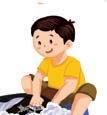


Have fun sharing and discussing your favourite books!
Being kind and honest is more important than wealth or greed
Author Page no CharacterInteresting
Name of the Book
DateDay
02/09/2024Monday Charlie and the Chocolate Factory Roald Dahl1 to 20 Charlie Bucket Willy Wonka’s magical chocolate factory
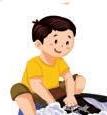
There is a fun reading list at the end of the Coursebook.

1. Please, Please the Bees by Gerald Kelley
https://bit.ly/beesby
2. I Need My Monster by Rita Moreno
https://bit.ly/monsterrita
3. The Gruffalo by Julia Donaldson
https://bit.ly/gruffalojulia
4. Sophie’s Masterpiece by Eileen Spinelli
https://bit.ly/masterpeice
5. Catching the Moon by Crystal Hubbard
https://bit.ly/catchingmoon
6. Frog and Toad Are Friends by Arnold Lobel
https://bit.ly/toadfriend
7. How Did That Get in My Lunchbox? by Chris Butterworth
https://bit.ly/thatlunchbox
8. Here We Are by Oliver Jeffers
https://bit.ly/byoliver
9. The Case of the Missing Carrot Cake by Robert Newman
https://bit.ly/casecarrot
10. Three Magic Balloons by Paul Margulies
https://bit.ly/magicpaul
11. The Magic School Bus Inside a Hurricane by Joanna Cole https://bit.ly/schoolmagic
12. How Tall, How Short, How Far Away by David A Adler https://bit.ly/fartall

13. The Boy at the Back of the Class by Onjali Q Raúf
14. Angry River by Ruskin Bond
15. The Magic of the Lost Temple by Sudha Murty
16. Chuskit Goes to School by Sujatha Padmanabhan
17. 365 Nature Stories by Ranjit Lal
18. Fur and Feathers retold by Elain Lindy ‘ https://bit.ly/lindyfur
19. Mousey the Merchant retold by Elaine Lindy https://bit.ly/mousymerchant
20. The Witch Baba Yaga retold by Elaine Lindy https://bit.ly/witchbaba
Note: The first few books are read-alouds, but we have also suggested books that you can read on your own. The last three stories are from Stories to Grow By. You will find many more stories that you can read on this website! Happy reading and don’t forget to visit the library!
The only way to do all the things you’d like to do is to read. — Tom Clancy

Uolo wishes to thank the following entities for granting permission to use the copyrighted materials.
1. The Tiffin Gang is written by Shweta Ganesh Kumar. © Pratham Books, 2019. The Weightlifting Princess is written by Sowmya Rajendran. © Pratham Books, 2018. Sailing Home is written by Subhadra Sen Gupta. © Pratham Books, 2005. Released under CC BY 4.0 license on StoryWeaver. The names and a few other edits have been made by Uolo EdTech Pvt Ltd for use in this textbook.
2. The Toothbrush Brigade is written by M.E. Stokes.
3. Doctor Doctor from Grandma’s Bag of Stories by Sudha Murty, published by Penguin Random House India under its imprint Puffin, © Sudha Murty, 2012.
4. Travel For Fun is written by Santhini Govindan.
5. The Cow is written by Robert Louis Stevenson.
6. The Magpie’s Nest is written by Joseph Jacobs.
7. Wind on the Hill is written by A A Milne.
8. I Woke Up this Morning is written by Kenn Nesbitt copyright © 2021. All Rights Reserved. Reprinted by permission of the author.
Every effort has been made to trace the copyright holders and to obtain permission for the use of copyright material. Where Uolo Edtech Pvt Ltd has not heard from them at the time of going to press, Uolo Edtech Pvt Ltd would be grateful for any information that would enable them to include appropriate acknowledgement in future reprints/editions of this book.

Introducing Ignite, a thoughtfully-crafted ELT programme designed especially for 21st century learners. In keeping with the National Education Policy (NEP) 2020’s focus on holistic education, Ignite provides opportunities for learners to hone their language skills as well as other 21st century skills. This programme offers a comprehensive language-learning experience supporting the all-round development of learners in line with the learning outcomes of the National Curriculum Framework (NCF) 2023.
• Coursebook
• Workbook thematically aligned with the Coursebook
• Uolo App
• Teacher Guide
• Diverse Literature Compilation of rich literature set in local and global contexts to expose learners to different cultures and build national pride
• Recommended Reading List A suggested reading list and a reading tracker to foster the culture of reading and sharing
• Experiential Projects Opportunities to apply language skills to prepare learners for reallife challenges
• Progress Tracker Tool to empower parents and teachers to track student growth, highlight skill gaps and support year-round development
• Skill-Based Assessments Continuous and comprehensive assessments tailored to promote competency-based learning, along with model papers to enhance teacher support
Uolo partners with K-12 schools to provide technology-enabled learning programs. We believe that pedagogy and technology must come together to deliver scalable learning experiences that generate measurable outcomes. Uolo is trusted by over 15,000+ schools across India, Southeast Asia and the Middle East.
ISBN 978-81-980680-0-2
